Beobachtungen:
Aktive Elemente
Bei einem Ventilator wird auf der einen Seite Luft angesaugt und auf der anderen Seite strömt sie heraus.
Übertragen auf spürbare Effekte bedeutet es:
Bei manchen Körpern lassen sich "Strömungen" mit unterschiedlichen Richtungen spüren.
Auf der einen Seite "kommt etwas heraus" und auf der einen Seite "geht etwas hinein".
Diese Effekte findet man bei z.B. bei Magneten, Batterien, Pflanzenstengeln, Hölzern usw.
Was ist für den Antrieb dieser "Strömungen" verantwortlich?
Was aktiviert sie, diese AKTIVEN ELEMENTE?
Bei Bewegung: Der Raum, der sie umgibt, wird wie eine anhaftende Flüssigkeit mitgezogen?
In a fan, air is sucked in on one side and flows out on the other.
Transferred to perceptible effects it means:
With some bodies "currents" with different directions can be perceived.
On one side "something comes out" and on the other side "something goes in".
These effects can be found at e.g. magnets, batteries, plant stalks, woods etc.
What is responsible for the drive of these "currents"?
What activates them, these ACTIVE ELEMENTS?
In motion: The space surrounding them is pulled along like an adhering liquid?
0. Einführung, Grundlagen
0.01 Welle-Teilchen
0.02 Wellen strukturieren Teilchen
1. Objekte und Beobachtungen bisheriger Versuche
1.1 Verformung, Magnete, Batterien, Strömung
1.1.2 Magnesiumstab steckt in Pertinax-Scheibe
1.1.3 Weitere Metalle und Pertinax-Scheibe, Anregung eines Wirbels
1.2 Die Wirkung von Wismut bei Magneten, Batterien und anderen aktiven Körpern
1.3 Einfluß der Temperatur auf aktive Körper
2. Einfache Versuchsobjekte für jederman, Obst und Gemüse
3. Erweiterte Experimente, oszillierende Bewegung
4. Anregung durch oszillierende Bewegung
5. Rotierende Strömungen
5.1 Luftstrom und elektrisches Drehfeld
5.2 Ventilator
0. introduction, basics
Wave-particle
Waves structure particles
1. objects and observations of previous experiments
1.1 Deformation
1.2 The effect of bismuth on magnets, batteries and other active bodies
1.3 Influence of temperature on active bodies
2. simple experimental objects for everyone, fruits and vegetables
3. advanced experiments, oscillating motion
4. excitation by oscillating motion
5. rotating currents
5.1 Air flow and rotating electric field
5.2 Fan
0. Einführung, Grundlagen
Introduction, basics
Welle und Teilchen
Beobachtungen in der geometrischen Optik:
Das huygenssche Prinzip (nach Christiaan Huygens und Augustin Jean Fresnel), besagt,Voraussetzung: Die Wellenfront muß auf eine Grenzfläche treffen.
dass jeder Punkt einer Wellenfront als Ausgangspunkt einer neuen Welle, der
so genannten Elementarwelle, betrachtet werden kann.
Die neue Lage der Wellenfront ergibt sich durch Überlagerung (Superposition) sämtlicher Elementarwellen.
Da die Elementarwelle eine Kugelform bzw. Kreisform hat, bildet sich auch eine rücklaufende Welle.
aus https://de.wikipedia.org/wiki/Huygenssches_Prinzip
Wave and particles
Observations in geometrical optics:
The Huygens principle (after Christiaan Huygens and Augustin Jean Fresnel), states,
that every point of a wave front can be considered as the starting point of a new wave, the so called
so-called elementary wave.
The new position of the wave front results from superposition of all elementary waves.
Since the elementary wave has a spherical or circular shape, a retrograde wave is also formed.
from https://de.wikipedia.org/wiki/Huygenssches_Prinzip
Precondition: The wave front must meet a boundary surface.
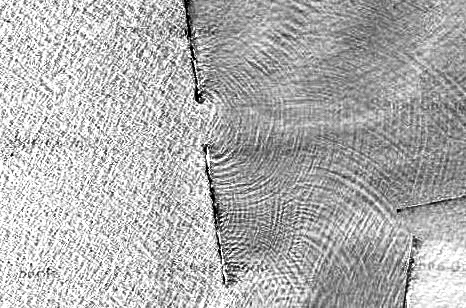 |
| Abb. A-01: Grenzflächen
beeinflussen Wellen Huygens-Prinzip, Wasserwellen vor einer Hafeneinfahrt erzeugen Kreiswellen im Hafenbecken Boundary surfaces influence waves Huygens principle, water waves in front of a harbor entrance generate circular waves in the harbor basin |
 |
Abb. A-02: Brechungaus brechungsindex.htm |
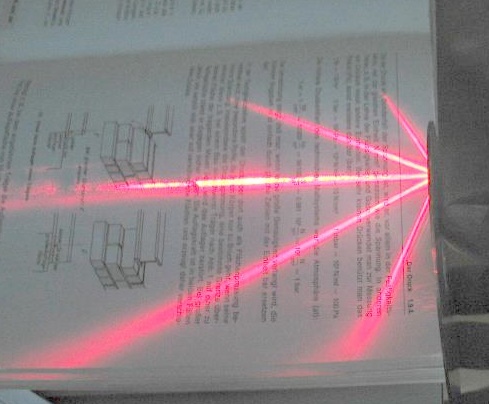 |
Abb. A-02a: Beugungaus gitterbeugung.htm |
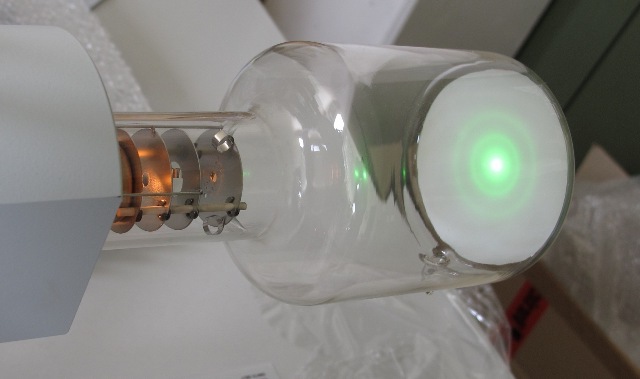 |
| Abb. A-03: Beugung von
Elektronen an einer runden Blende Links ist die Elektronenquelle (Glühdraht) und rechts der Leuchtschirm Diffraction of electrons at a round aperture On the left is the electron source (filament) and on the right the phosphor screen (FB) |
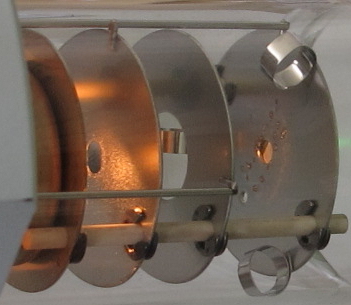
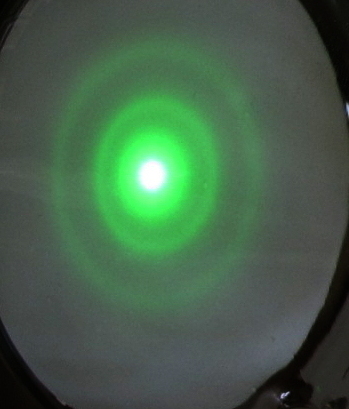 |
| Abb. A-03a: Ausschnitte aus
vorheriger Abbildung mit anderem Kontrast links von der Mitte die runde Blende Cutouts from previous image with different contrast left from the center the round aperture (FB) |
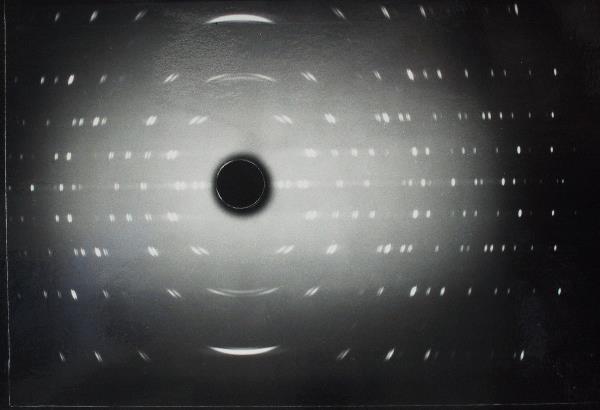 |
| Abb. A-03a: Beugung Röntgenstrahlen werden von dem atomaren Gitter eines Festkörpers gebeugt. gamma-messing gitterbeugung.htm Diffraction X-rays are diffracted by the atomic lattice of a solid. (FB) |
0.01Welle-Teilchen
Teilchen strukturieren Wellen
Wellen in Flüssigkeiten und Gasen
Wave-particle
Particles structure waves
Waves in liquids and gases
 |
| Abb.
A-04:
Teilchen strukturieren Wellen Zwei Düsen über einer Wasserfläche. Dort strömt periodisch ein Luftstrom heraus. andere Formulierung: An zwei Orten trifft ein Teilchenstrom periodisch auf die Oberfläche. Es würde auch mit zwei mechanischen Tastern funktionieren. Particles structure waves Two nozzles above a water surface. There an air stream flows out periodically. other formulation: A stream of particles hits the surface periodically at two places. It would also work with two mechanical probes. (FB) |
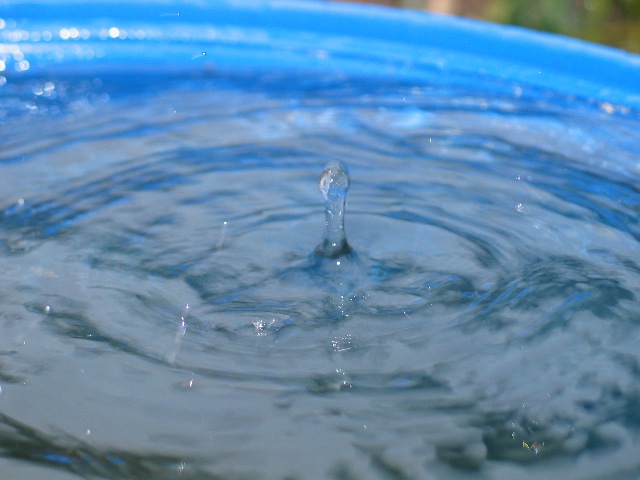 |
| Abb. A-04a: Ein Wassertropfen ist auf
die Wasseroberfläche gefallen. Die Oberfläche
reagiert elastisch. Es entsteht ein noch oben
gehender Wassertropfen. Dabei bilden sich Wellen. A drop of water has fallen onto the water surface. The surface reacts elastically. A drop of water still going upwards is formed. Waves are formed in the process. (FB) |
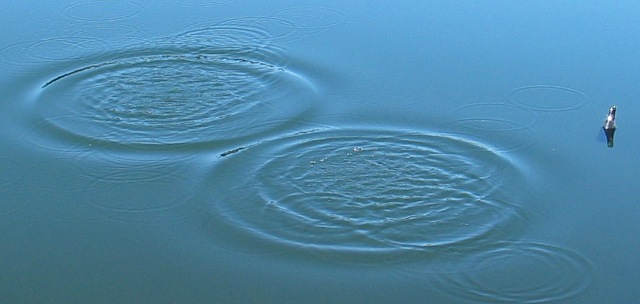 |
| Abb.
A-04b:
Teilchen strukturieren Wellen Zwei Teilchen (Steine) fielen gleichzeitig ins Wasser. (rechts schwimmt eine Bierflasche) Particles structure waves Two particles (stones) fell into the water at the same time. (a beer bottle floats on the right) (FB) |
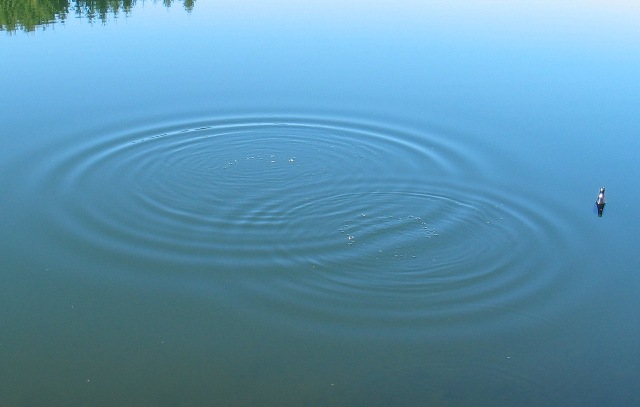 |
| Abb. A-05:
Teilchen strukturieren
Wellen Die beiden Teilchen (Steine) haben jeweils Kreiswellen ausgelöst, die sich nun überlagern. Die Teilchen sind nicht mehr sichtbar, die Wellen allerdings noch lange Zeit. Particles structure waves The two particles (stones) have each triggered circular waves which are now superimposed. The particles are no longer visible, but the waves are still visible for a long time. (FB) |
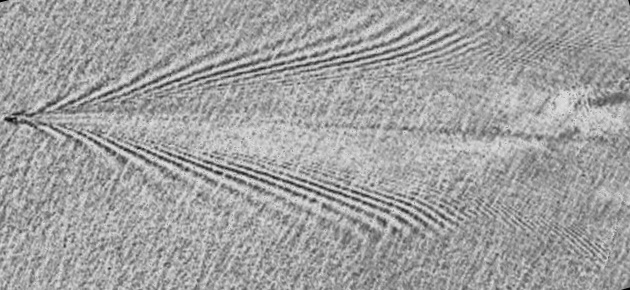 |
| Abb. A-06:
Teilchen strukturieren Wellen Ein Boot fährt auf dem Wasser. Es entstehen Wellen. Particles structure waves A boat is sailing on the water. Waves are created.(FB) |
 |
Abb. A-06a: Teilchen
strukturieren Wellenaus wasser-ader-drei-02.htm#kapitel-10 |
0.02 Wellen strukturieren Teilchen
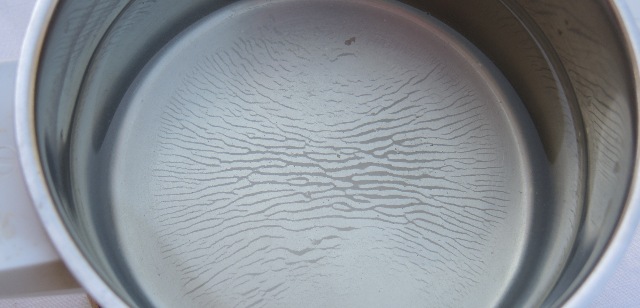 |
| Abb. A-07: Wellen strukturieren
Teilchen. Wasser mit feinen Teilchen wurde bewegt (geschüttelt), dabei entstanden Wellen. Die Teilchen wurden von ihnen mitgenommen und haben sich nun nach Abklingen der Wellen am Boden strukturiert. Sie bilden einen Teil der Wellen ab. Waves structure particles. Water with fine particles was moved (shaken), waves were created. The particles were carried along by them and have now structured themselves on the ground after the waves have subsided. They represent a part of the waves. (FB) |
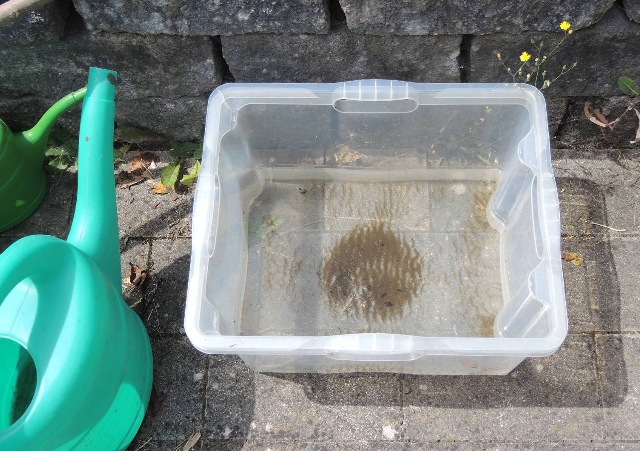 |
| Abb. A-08: Flache Schüssel mit Wasser
und etwas Sand Shallow bowl with water and some sand (FB) |
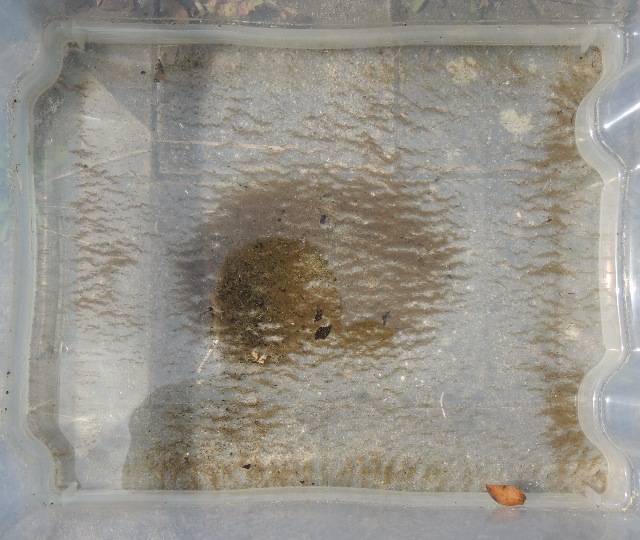 |
| Abb. A-09: Nach einer Anregung durch
leichtes Gegentreten von unten, die Wellen
haben eine horizontale Ausrichtung der Strukturen erzeugt. After an excitation by light counterstepping from below, the waves have a horizontal alignment of the structures produced. (FB) |
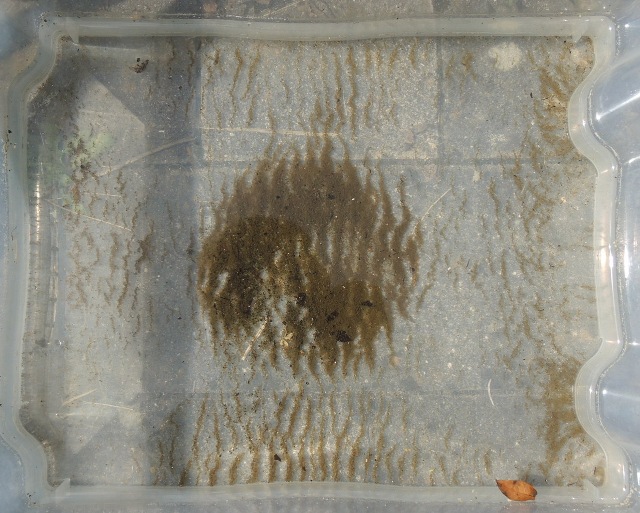 |
| Abb. A-10: Nach einer Anregung durch
leichtes Gegentreten von rechts, haben die Wellen eine vertikale Ausrichtung der Strukturen erzeugt. After an excitation by light counterstepping from the right, the waves have created a vertical alignment of the structures. (FB) |
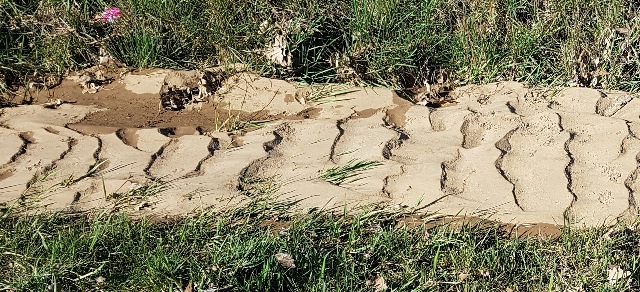 |
| Abb. A-11: Wellen strukturieren
Teilchen. Nach Starkregen hat sich hier ein kleiner Bach gebildet, der etwas vom Acker weggeschwemmt hat. Die Wellen auf dem Wasser haben im Sand Strukturen gebildet. Waves structure particles. After heavy rain, a small stream has formed here, which has washed away something from the field. The waves on the water have formed structures in the sand.(FB) |
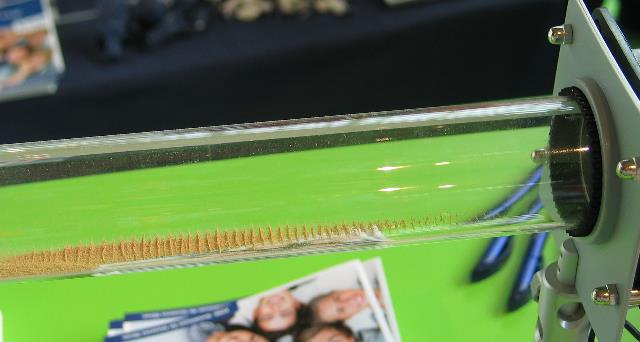 |
Abb. A-11: Wellen strukturieren
Teilchen.aus stehende-welle.htm |
0.03 Torsionswellen in einem Draht
Torsion waves in a wire
Torsionspendelkette
aus kuehlwasser-dreizehn.htm#torsionspendelkette
siehe wellen.htm#torsionspendelkette
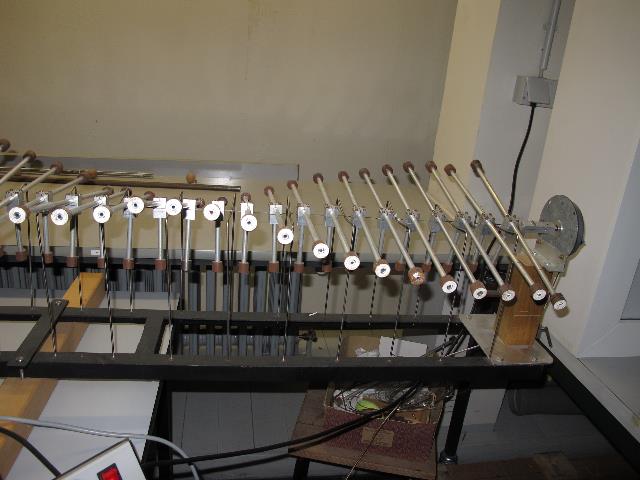 |
Abb. A-12:Abb. 04-01: Laufende Welle erzeugt im Gegensatz zu einer stehenden stark spürbare Effekte. |
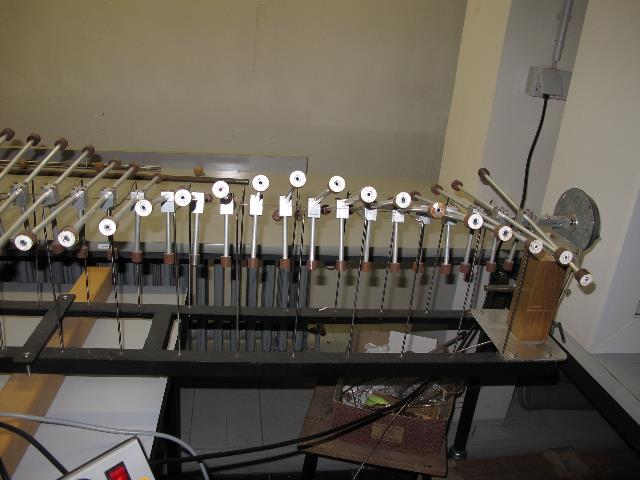 |
Abb. A-13:Abb. 04-02: Laufende Welle erzeugt im Gegensatz zu einer stehenden stark spürbare Effekte. |
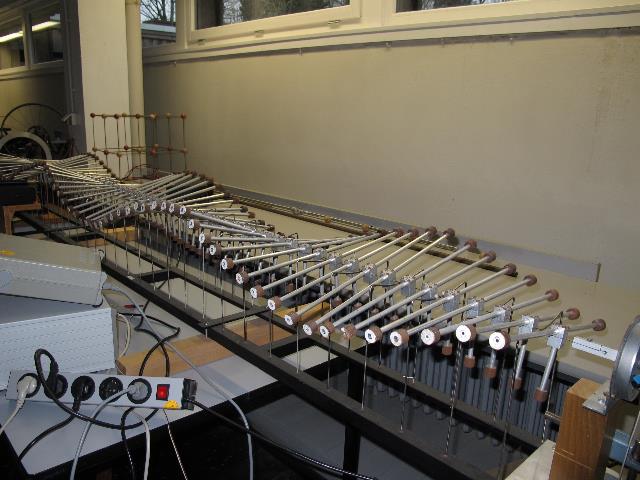 |
Abb. A-14:Abb. 04-03: Laufende Welle erzeugt im Gegensatz zu einer stehenden stark spürbare Effekte. |
0.04 Wellen im Volumen einer Flüssigkeit
Waves in the volume of a liquid
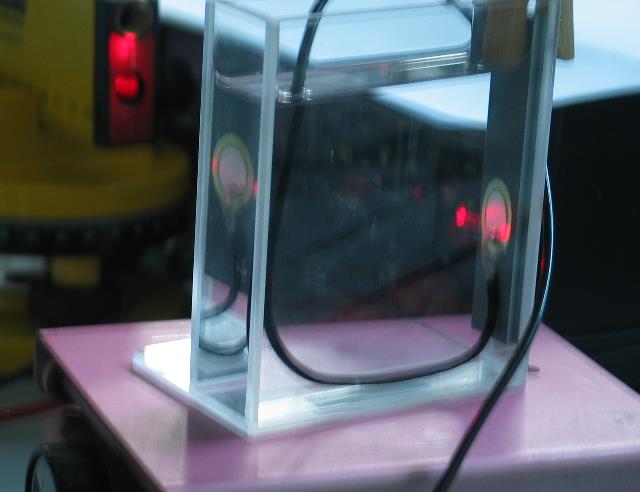 |
Abb. A-15: Stehende Wellen im
Flüssigkeitsvolumen aus brechungsindex.htm |
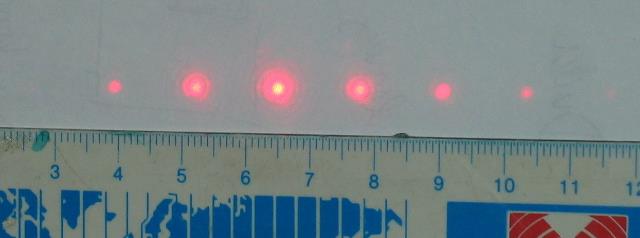 |
Abb. A-16: Die stehenden Wellen im
Flüssigkeitsvolumen wirken als Beugungsgitteraus brechungsindex.htmDiffraction image of a laser beam generated by ultrasonic standing waves in alcohol, Width of cuvette: 76 mm, distance from cuvette to diffraction pattern: 4.8 m, frequency: 4.8 MHz. From some of these data the sonic velocity of alcohol can be determined, if in addition the laser wavelength (about 650 nm) is known. c-Ethanol = 1168 m/s according to Wikipedia (FB) |
0.05 Wellen in Festkörpern
Waves in solids
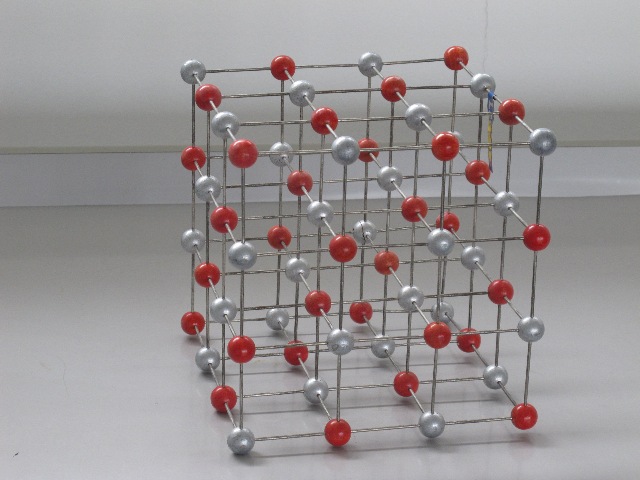 |
| Abb. A-17: Festkörper mit zwei
unterschiedlichen Atomsorten. Rot und silber sollen Atome mit unterschiedliche Ladungen andeuten. Hier können sichsowohl mechanische Wellen als auch elektrische Wellen ausbreiten. Solid with two different types of atoms. Red and silver indicate atoms with different charges. Both mechanical and electrical waves can propagate here.(FB) |
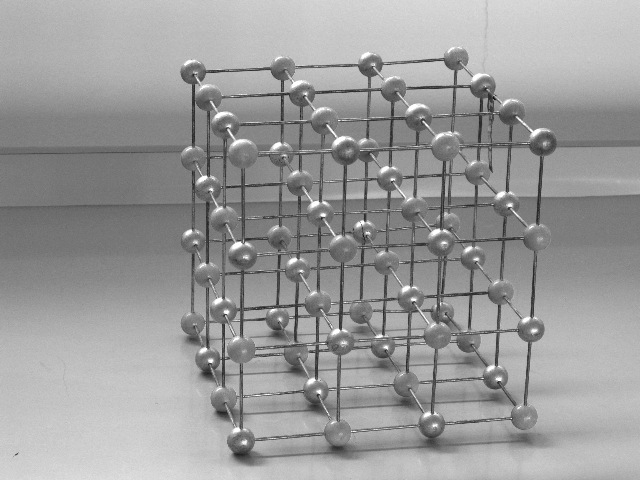 |
| Abb. A-18: Der gleiche Aufbau, aber
ohne unterscheidbare Atome. Hier können sich nur mechanische Wellen ausbreiten. The same structure, but without distinguishable atoms. Only mechanical waves can propagate here. (FB) |
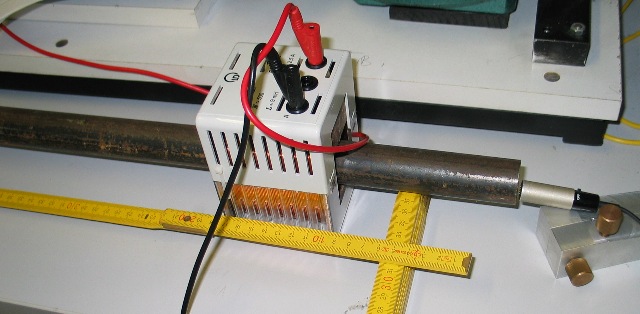 |
Abb. a-19: Magnetostriktion, der
Eisenstab verändert seine Länge in einem Magnetfeld.aus stehende-welle.htm |
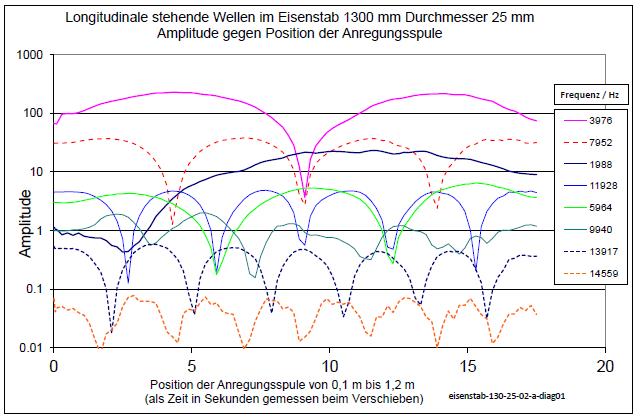 |
Abb. A-20: Wellen im Eisenstabaus stehende-welle.htm |
0.06 Formen Forms
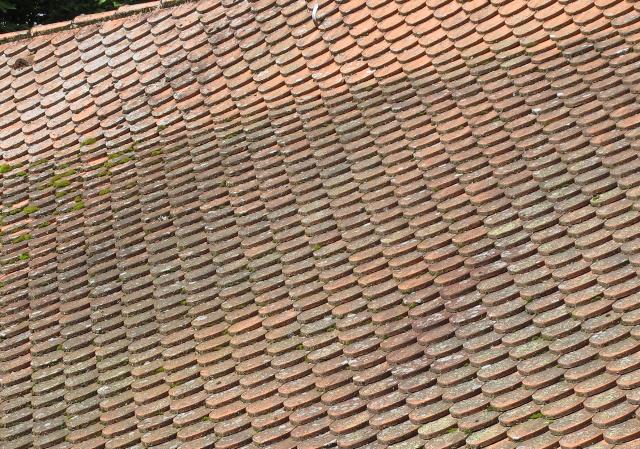 |
| Abb. A-21: Dachziegel, Biberschwänze
bilden eine regelmäßige Struktur von Flächen und
Kanten Roof tiles, plain tiles form a regular structure of surfaces and edges aus bbewegte-materie.htm#kapitel-02-04 |
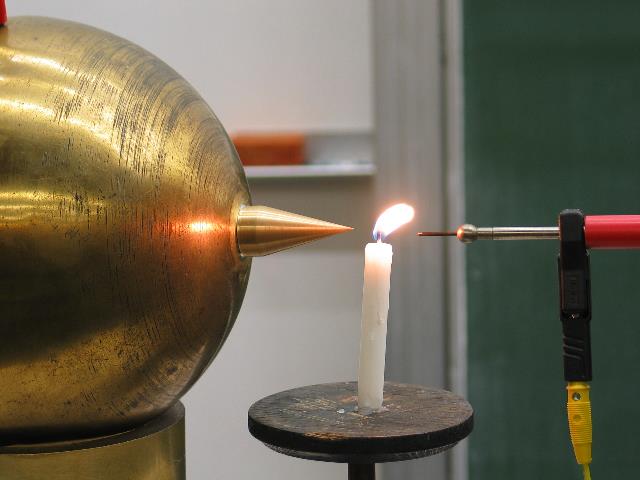 |
Abb. A-22:aus lichtquellen.htm |
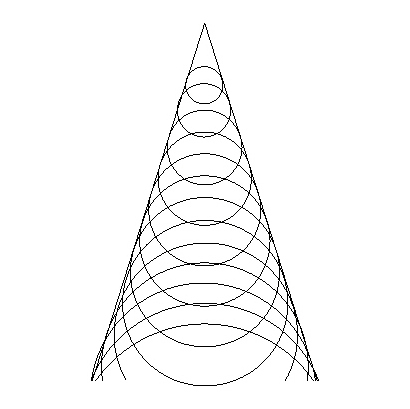 |
||||||||||||
| Abb. 00-01: schematisch:
Kreiswellen in einem Keil schematic: circular waves in a wedge (FB) |
||||||||||||
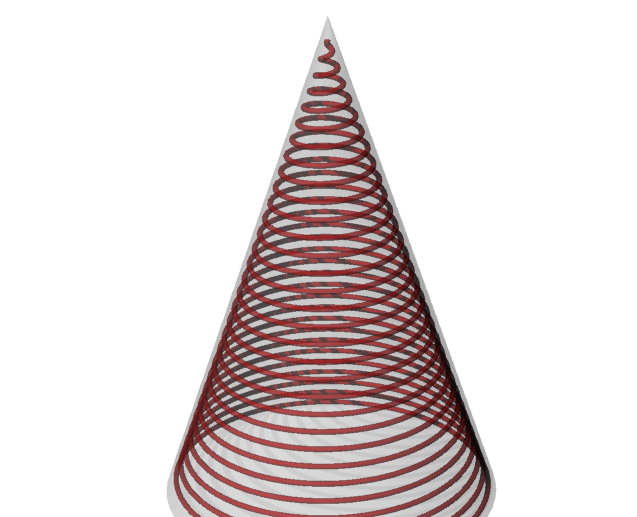 |
||||||||||||
Abb. 00-02: ähnlich wie auf dem
Umschlag von similar
to the cover of D.A. Davidson |
||||||||||||
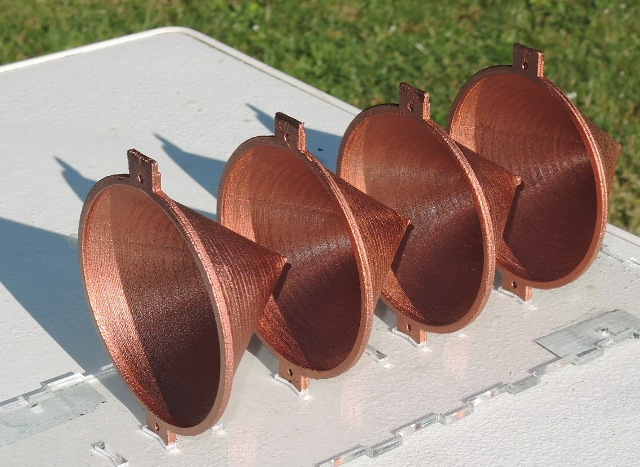 |
||||||||||||
Abb. 00-03:aus konische-koerper.htm#kapitel-02 |
||||||||||||
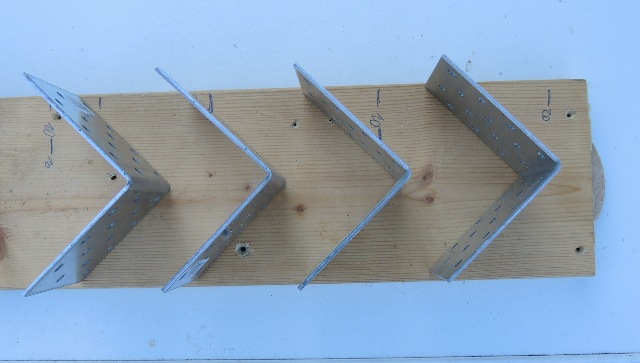 |
||||||||||||
Abb. 00-04:aus konische-koerper.htm#kapitel-03-03 |
||||||||||||
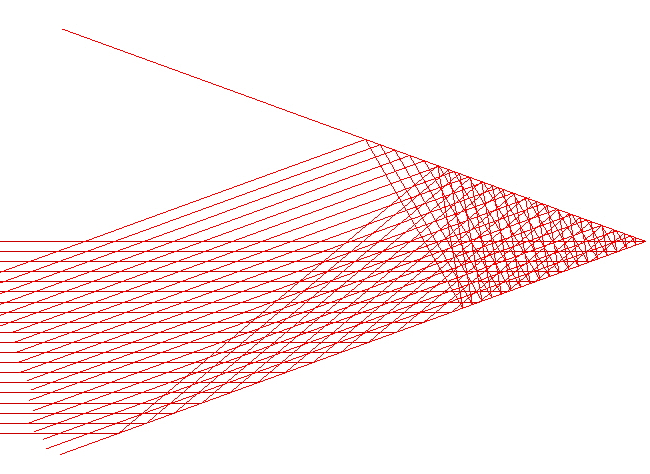 |
||||||||||||
| Abb. 05: schematisch: ein
Bündel von parallelen Lichtstrahlen (halbe
Breite) trifft von links kommend auf zwei
reflektierende keilförmige Grenzflächen
(Öffnungswinkel 40°). schematic: a bundle of parallel light beams (half width) coming from the left hits two reflecting wedge-shaped boundary surfaces (aperture angle 40°) (FB) |
||||||||||||
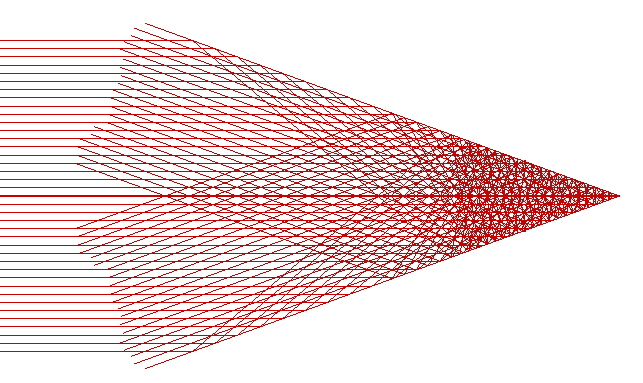 |
||||||||||||
| Abb.00-05a: schematisch: ein Bündel
von parallelen Lichtstrahlen (ganze Breite)
trifft von links kommend auf zwei reflektierende
keilförmige Grenzflächen (Öffnungswinkel 40°). Nach
mehreren Reflexionen teilt sich das Bündel auf in
zwei Hälften. Nun verlassen die Lichtstrahlen die
Öffnung parallel zur Richtung der Grenzflächen
(gezeichnet mit ungleichen Längen). Im Bereich der Spitze des Keils gibt es sehr viele Reflexionen und sehr viele sich kreuzende Lichtstrahlen. schematic: a bundle of parallel light rays (full width) coming from the left hits two reflecting wedge-shaped boundary surfaces (aperture angle 40°). After several reflections, the bundle splits into two halves. Now the light rays leave the aperture parallel to the direction of the interfaces (drawn with unequal lengths). In the area of the tip of the wedge there are very many reflections and very many crossing light rays.(FB) |
||||||||||||
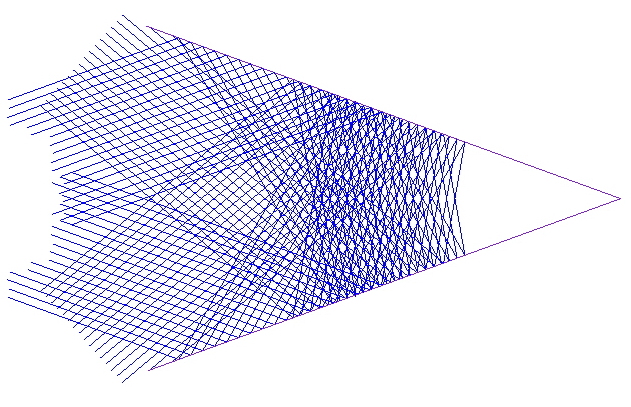 |
||||||||||||
| Abb. 00-06: schematisch: die beiden
(roten) Bündel des austretenden Lichtes wurden
jeweils auf die volle Breite ergänzt (gezeichnet mit
ungleicher Länge der Strahlen). Wird in Richtung
dieser Ergänzungen von links eingestrahlt, dann
entstehen zwei neue Bündel (gezeichnet mit gleicher
Länge der Strahlen), die schräg nach oben bzw. nach
unten den Keil verlassen. Bei dieser Anordnung
bleibt der Bereich bei der Spitze des Keils frei. schematic: the two (red) bundles of the exiting light were each supplemented to the full width (drawn with unequal length of the beams). If the light is irradiated from the left in the direction of these additions, then two new bundles (drawn with equal length of the rays) are created, which leave the wedge obliquely upwards and downwards, respectively. In this arrangement, the area at the tip of the wedge remains free. (FB) |
||||||||||||
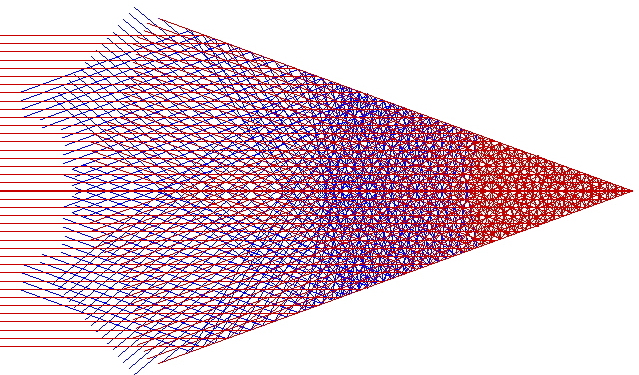 |
||||||||||||
| Abb. 00-07: Bündel mit gerader (rot)
und schräger (blau) Einstrahlung überlagert. Bundles with straight (red) and oblique (blue) irradiation superimposed. (FB) |
||||||||||||
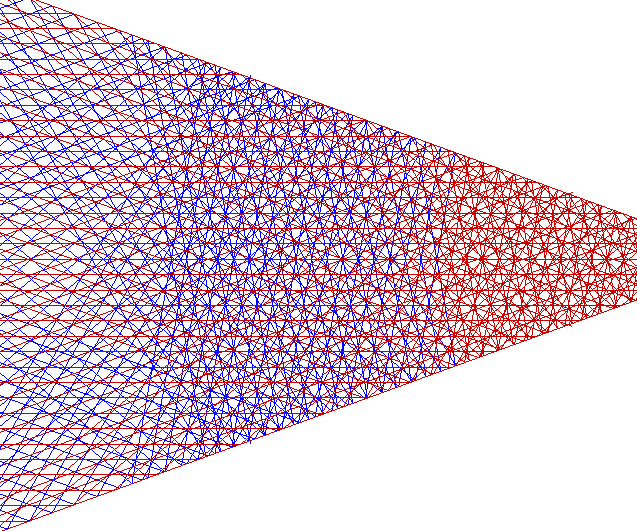 |
||||||||||||
| Abb. 00-08: Ausschnitt, sehr viele
Reflexionen, sehr viele Kreuzungen Detail, very many reflections, very many crossings (FB) |
||||||||||||
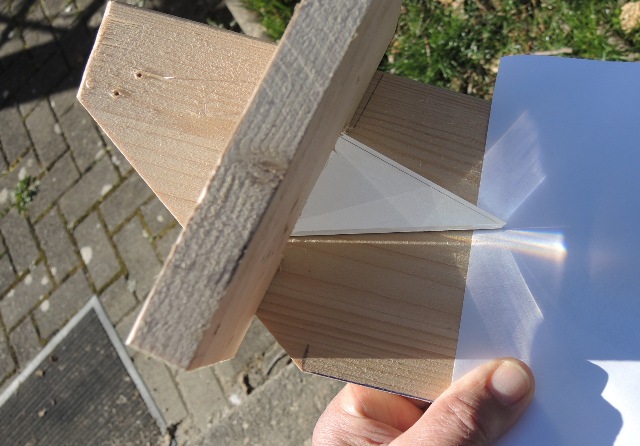 |
||||||||||||
| Abb. 00-09: (Sonnenlicht fällt
auf ein Prisma. Es gibt drei Richtungen, in die das
Licht reflektiert wird. In der mittleren Richtung ist es besonders intensiv. Sunlight falls on a prism. There are three directions in which the light is reflected. It is particularly intense in the middle direction. (FB) |
||||||||||||
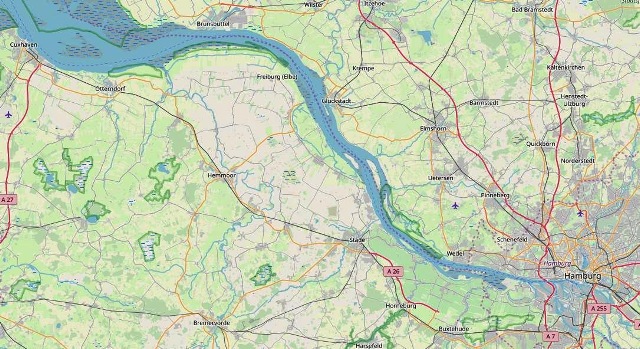 |
||||||||||||
| Abb. 00-10: Elbe, Trichtermündung (opentopomap.org) Mit zunehmender Entfernung von der Mündung nimmt der Tidenhub zu. Elbe, funnel mouth (opentopomap.org) The tidal range increases with increasing distance from the mouth. Tidenhub der Elbe vom 01.03.2020 bis 07.03.2020, gemittelte Werte (elbe-trichter-gezeiten.xlsx)
https://gezeitenfisch.com/de/hamburg/hamburg-st-pauli#_gezeitentabelle https://gezeitenfisch.com/de/hamburg/dove-elbe-einfahrt#_gezeitentabelle Wird die Flut in einer Bucht oder Trichtermündung zusammengepresst, entstehen Ausnutzung der Tide im Gezeitenkraftwerk Rance https://en.wikipedia.org/wiki/Rance_Tidal_Power_Station |
1. Objekte und Beobachtungen bisheriger Versuche
1.1 Verformung, Magnete, Batterien, Strömung
1. objects and observations of previous tests
1.1 Deformation
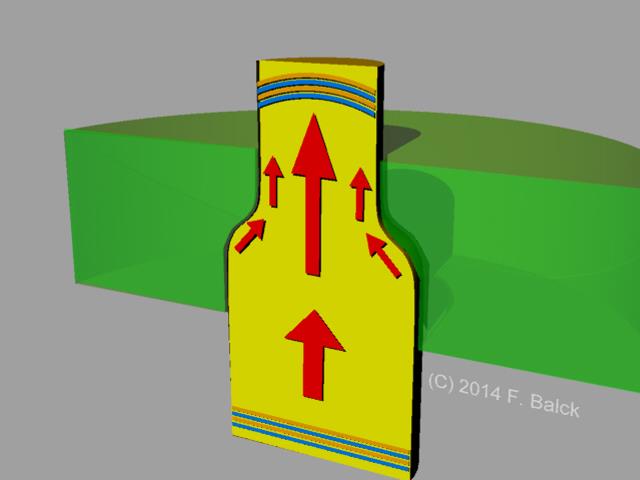 |
Abb. 01-01-01: Ziehrichtung bei
einem Drahtaus kabel-eigenschaft.htm#kapitel-02-01 |
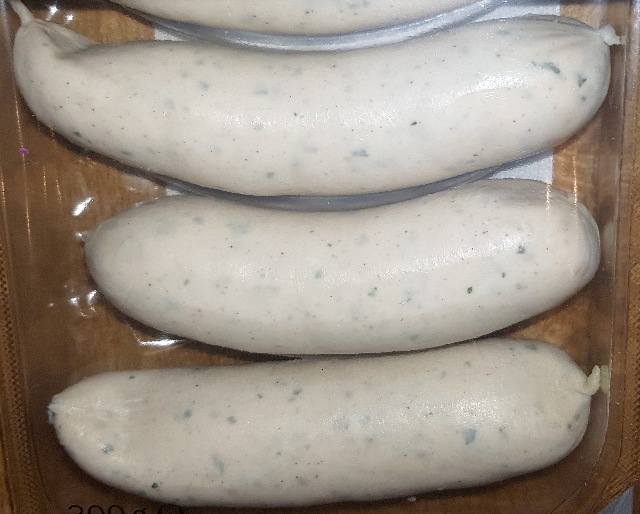 |
| Abb. 01-01-02: Abziehen der Haut
einer Weißwurst Beim Einpressen der Wurstmasse haben sich die Haut und die Masse so strukturiert, daß es eine Vorzugsrichtung gibt. (wie in Abb. 01-01 beim gezogenen Draht: Ziehrichtung, bei Pflanzen: Wachstumsrichtung) Beginnt man nun das Abziehen bei dem Ende mit der größeren spürbaren Struktur, löst sich die Haut nahezu vollständig. Dagegen bleiben beim Start am anderen Ende häufig noch Teile der Wurstmasse an der Haut haften. Peeling off the skin of a white sausage When the sausage mass is pressed in, the skin and the mass have structured themselves in such a way that there is a preferred direction. (as in Fig. 01-01 for drawn wire: drawing direction, for plants: Growth direction) If you now start the drawing at the end with the larger perceptible structure, the skin comes off almost completely. In contrast, when starting at the other end, parts of the sausage mass often still adhere to the skin. (FB) |
 |
Abb. 01-01-03: Durch eine Düse
gedrücktes Kupfer Copper
pressed through a nozzleaus maxwell-zwei.htm#kapitel-02 |
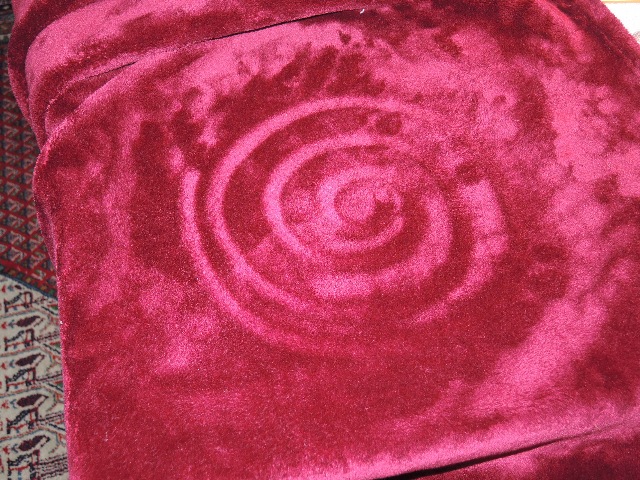 |
Abb. 01-01-04:aus fransen.htm |
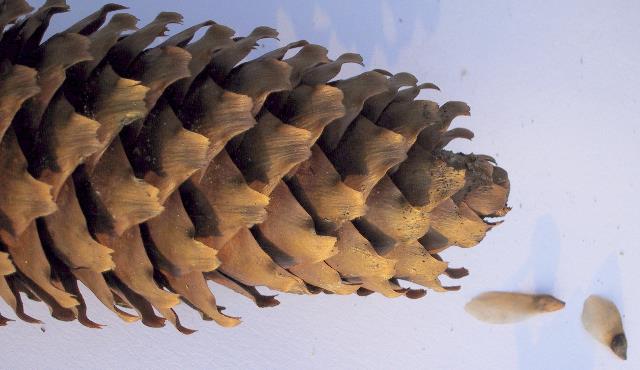 |
Abb. 01-01-05: Wachstumsrichtung beim
Tannenzapfen Growth
direction in pine coneaus bbewegte-materie.htm#kapitel-02-04 |
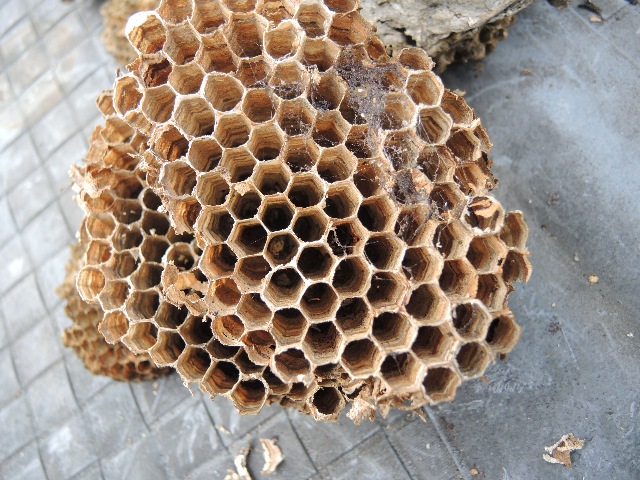 |
Abb. 01-01-05a: Wespennest (FB)aus konische-koerper.htm |
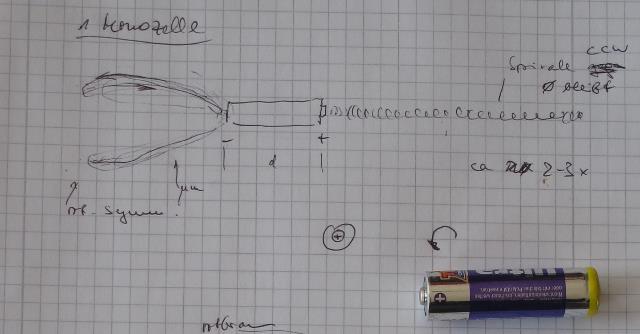 |
Abb. 01-01-06: Strukturen bei einer
Batterie Structures
at a batteryaus strom-sehen-009.htm#kapitel-09 |
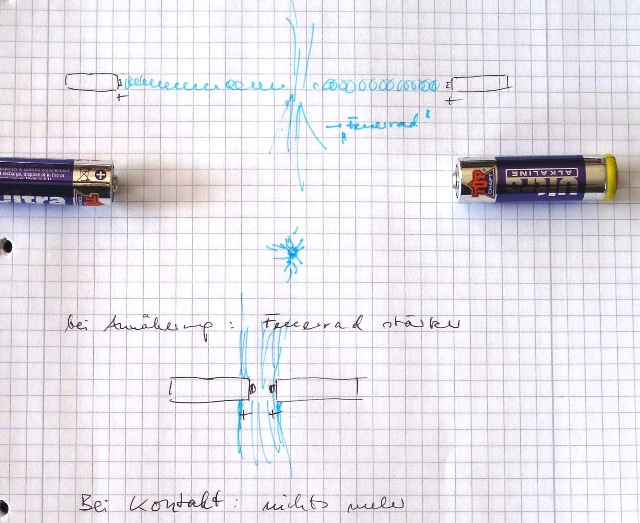 |
| Abb. 01-01-07: Strukturen von zwei
Batterien wechselwirken miteinander Structures of two batteries interact with each other aus strom-sehen-009.htm#kapitel-09 |
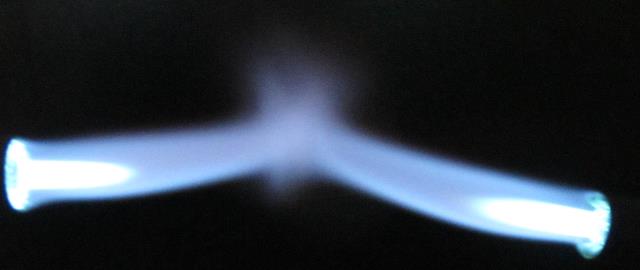 |
| Abb. 01-01-08: Zwei Gasflammen
wechselwirken miteinander Two gas flames interact with each other aus strom-sehen-009.htm#kapitel-09 |
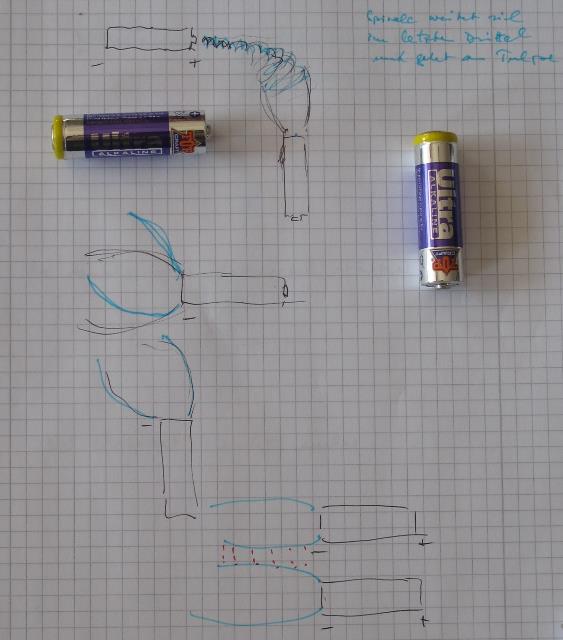 |
Abb. 01-01-09: Strukturen von
zwei Batterien wechselwirken miteinander
aus strom-sehen-009.htm#kapitel-09 |
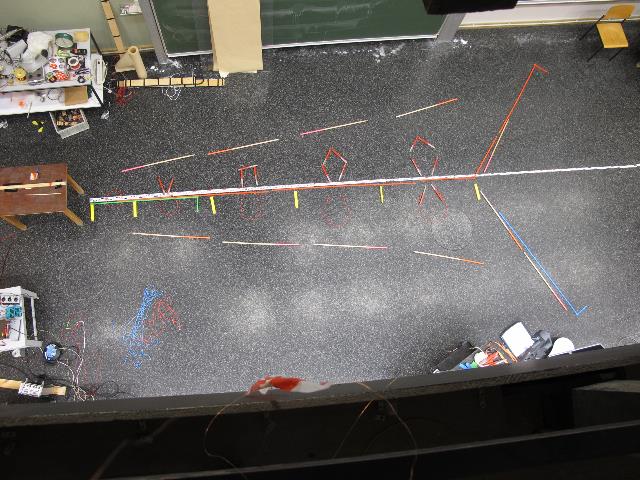 |
| Abb. 01-01-10: Eine 12 Volt Batterie
Typ A23 liegt auf dem Tisch und zeigt mit dem
Pluspol nach rechts. A 12 volt battery type A23 is lying on the table with the positive pole pointing to the right. aus kuehlwasser-achtzehn-08.htm#kapitel-08 |
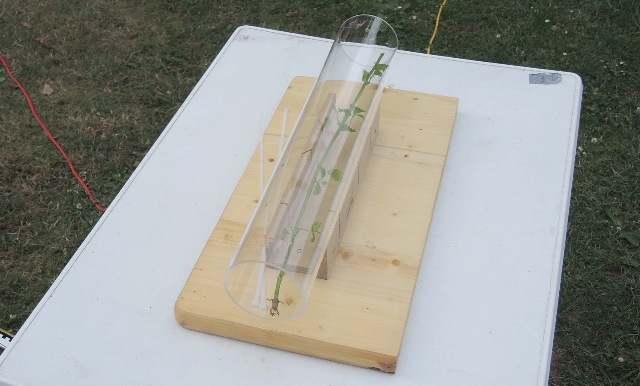 |
Abb. 01-01-11: Pflanze und
Quarzrohr Plant
and quartz tubeaus quarzrohr-angeregt.htm |
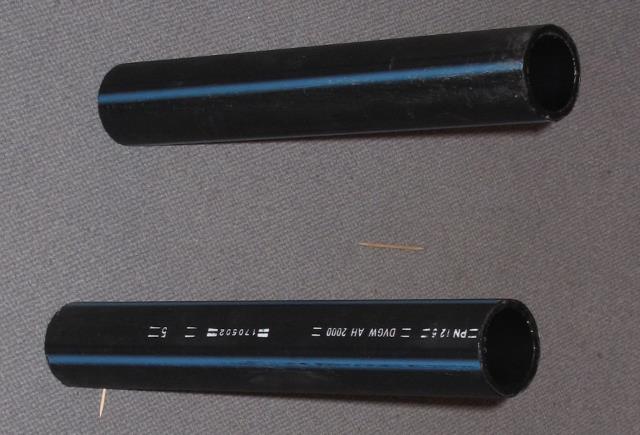 |
| Abb. 01-01-12: Stark verformte harte
PE-Rohre. Die Ziehrichtung läßt sich spüren. Heavily deformed hard PE pipes. The drawing direction can be perceived. aus kabel-eigenschaft.htm#kapitel-02-05 |
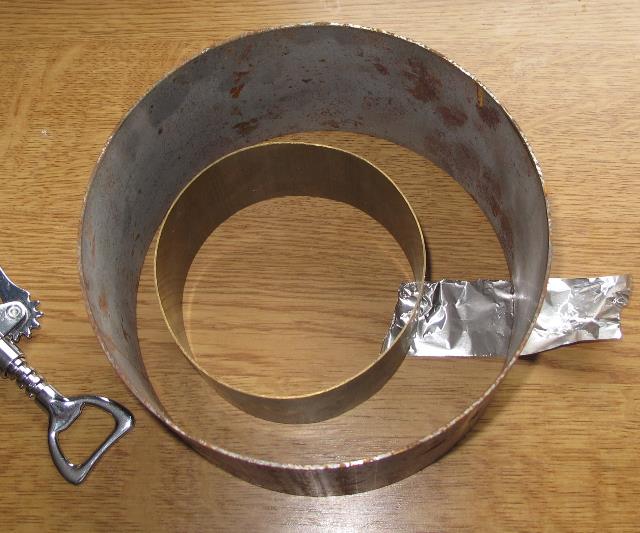 |
| Abb. 01-01-13: Zwei Rohre aus
unterschiedlichen Materialien und möglicherweise
auch ungleichen Ziehrichtungen Two tubes made of different materials and possibly also different drawing directions aus kabel-eigenschaft.htm#kapitel-02-05 |
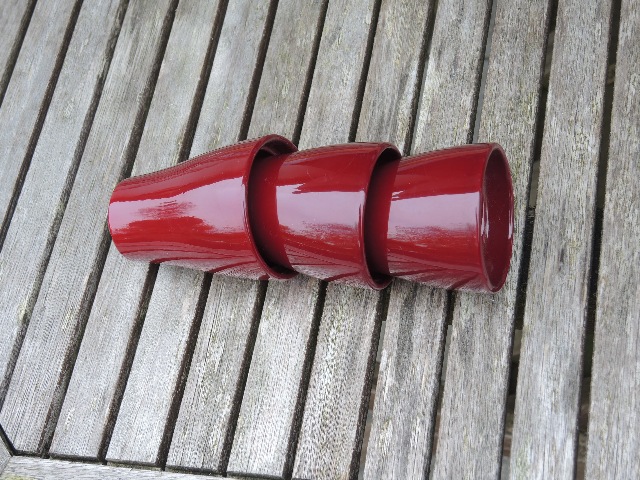 |
Abb. 01-01-14: konische Körper sind
aktive Elemente conical
bodies are active elementsaus maxwell-zwei.htm#kapitel-02 |
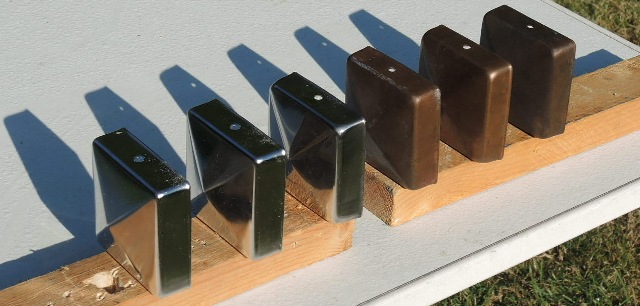 |
Abb. 01-01-15: konische Körper sind
aktive Elemente conical
bodies are active elementsaus konische-koerper.htm#kapitel03-03 |
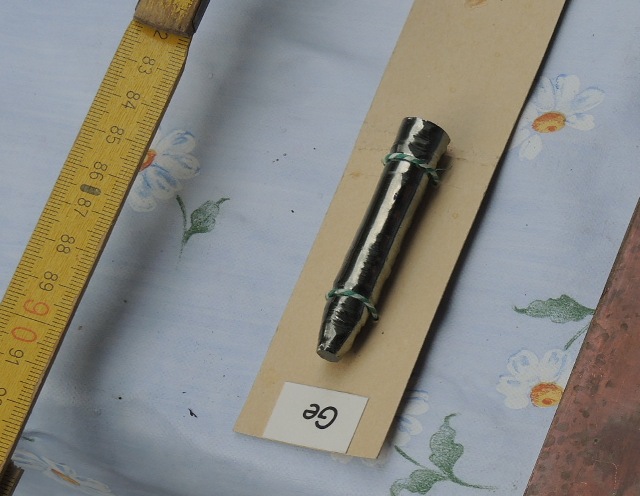 |
| Abb. 01-01-16: Germanium-Einkristall,
er ist sehr langsam aus einer Schmelze herausgezogen
worden. (Czochralski-Verfahren) https://de.wikipedia.org/wiki/Czochralski-Verfahren Das Wachstum hat bei dem dünnen Teil begonnen. Germanium single crystal, it has been pulled out very slowly from a melt. (Czochralski process) https://de.wikipedia.org/wiki/Czochralski-Verfahren The growth has started at the thin part. aus kuehlwasser-zwanzig-zwei.htm#kapitel-05 |
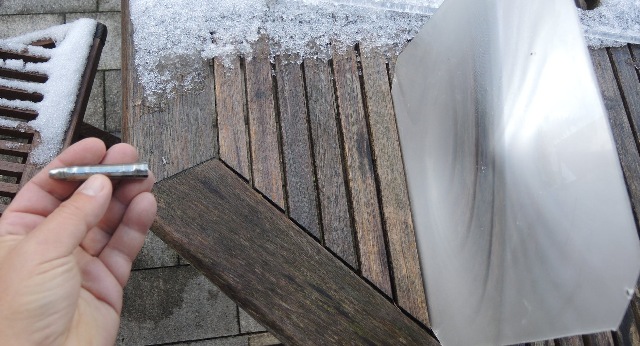 |
| Abb. 01-01-17: Germanium-Einkristall
vor einer Fresnel-Linse von einem OverheadProjektor Germanium single crystal in front of a Fresnel lens from an overhead projector (FB) |
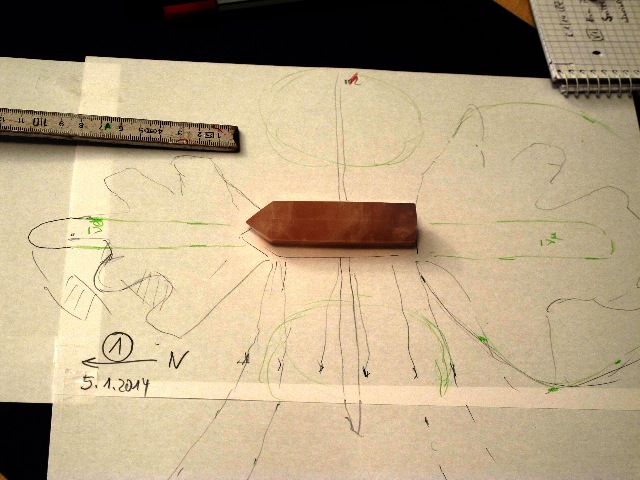 |
| Abb. 01-01-18: Geschliffener
Rosenquarz, der Kristall ist von rechts nach links
gewachsen. Cut rose quartz, the crystal has grown from right to left. aus rosenquarz.htm#kapitel-04-01 |
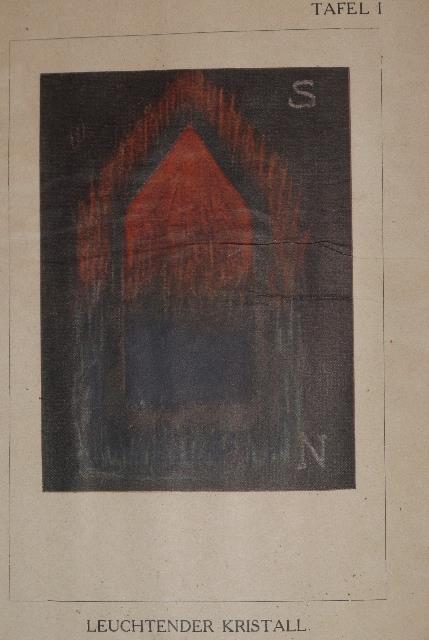 |
Abb. 01-01-19: Lichterscheinungen bei
einem Quarzkristall, rot und blau aus bbewegte-materie.htm#kapitel-02-01-03 |
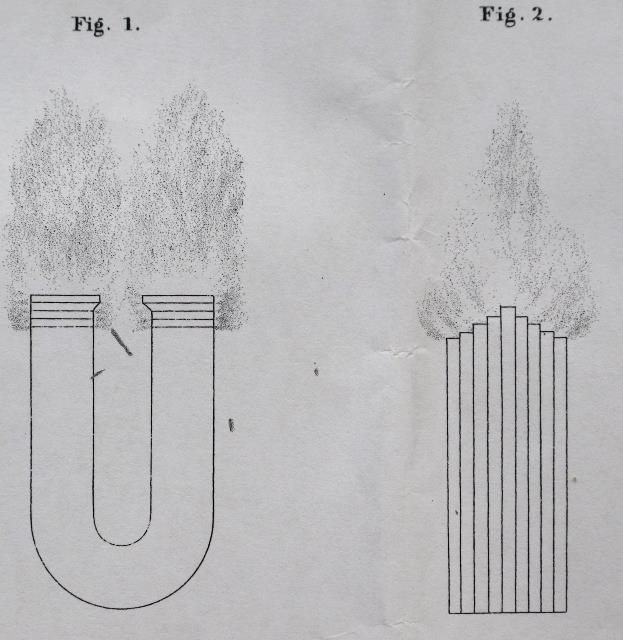 |
Abb. 01-01-20:aus bbewegte-materie.htm#kapitel-02-01-05 |
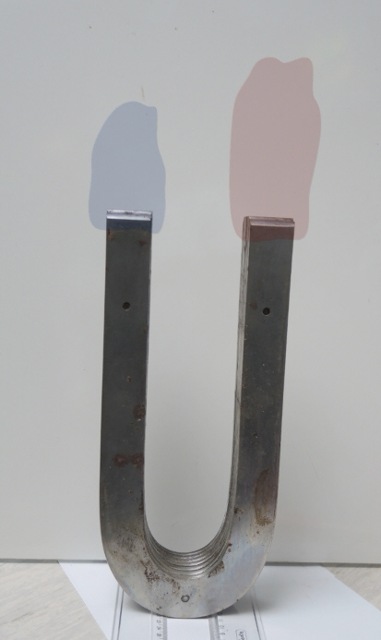 |
| Abb. 01-01-21: rot und blau sind die
von Reichenbach beschriebenen Farben. red and blue are the colors described by Reichenbach. aus bbewegte-materie.htm#kapitel-02-01-05 |
 |
| Abb. 01-01-22: Stabmagnet (FB) |
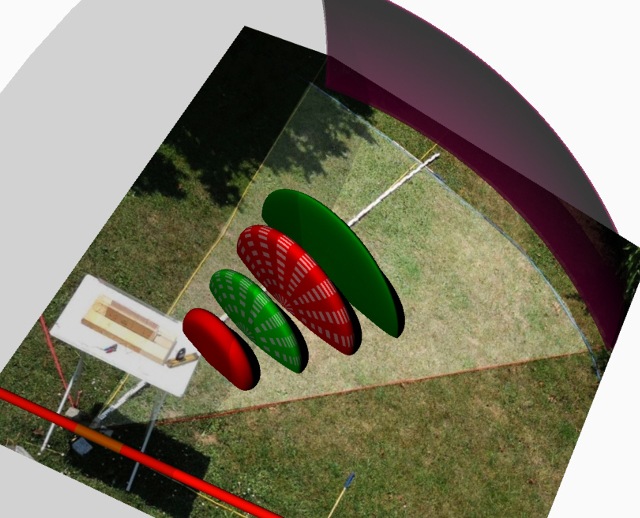 |
Abb. 01-01-23: Strukturen um ein
Quarzrohr aus quarzrohr-angeregt.htm |
 |
Abb. 01-01-24: aus stromleiter-rotierend.htm#kapitel-03-03 |
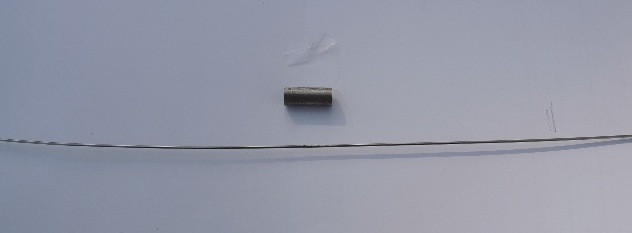 |
Abb. 01-01-25:aus transmutator.htm#kapitel-05 |
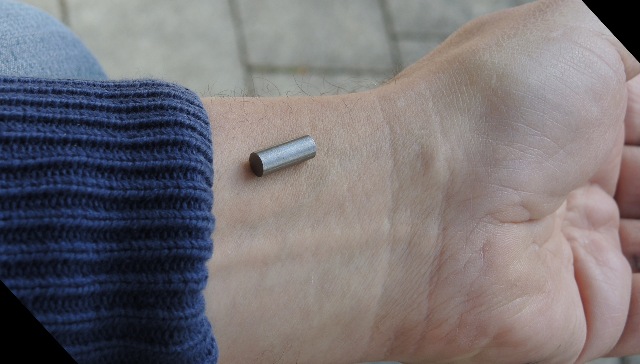 |
Abb. 01-01-26:aus transmutator.htm#kapitel-05 |
Nachweis unterschiedlicher Drehrichtungen an beiden Enden von einem aktiven Element mit einem Ring aus Plexiglas
stab-und-magnet.htm#kapitel-04-06
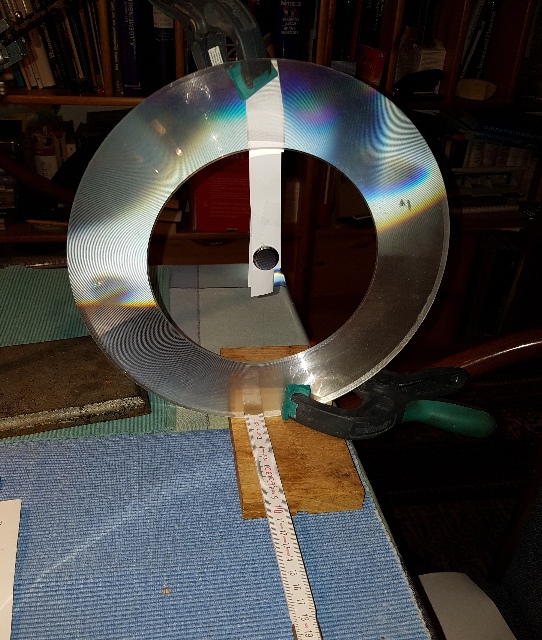 |
Abb. 01-01-27:
aus stab-und-magnet.htm#kapitel-04-06 |
 |
| Abb. 01-01-28: Die obere
Hälfte einer Karotte steckt in der Mitte vom Ring.
Die dabei entstehende Strömung im Ring zeigt nach
links, das wäre nach der Korkenzieherregel die
Drehrichtung CW (beim Blick von der Wurzel
zum Sproß). (FB) |
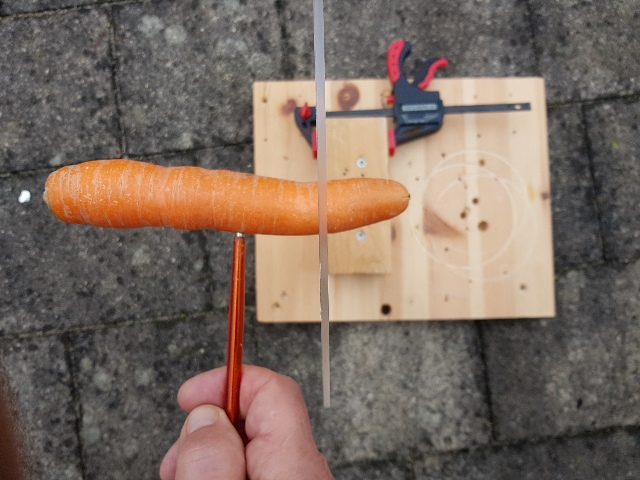 |
| Abb. 01-01-29: Die untere
Hälfte einer Karotte steckt in der Mitte vom Ring.
Die Strömung im Ring zeigt nach rechts. Das wäre
nach der Korkenzieherregel die Drehrichtung CCW
(beim Blick von der Wurzel zum Sproß). (FB) |
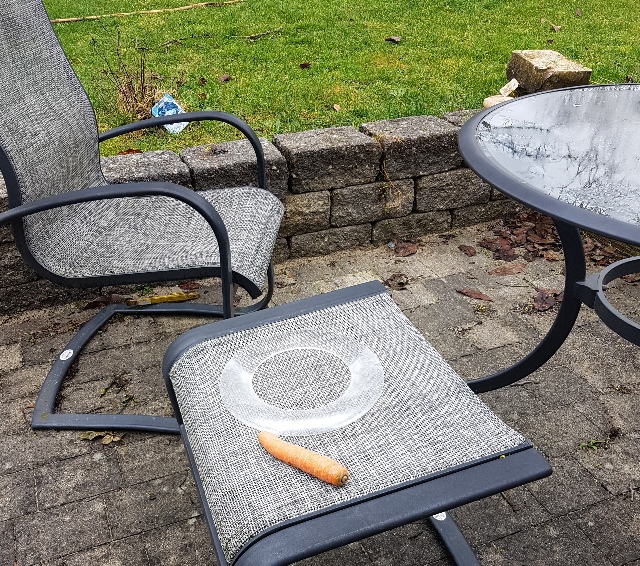 |
| Abb. 01-01-30: Tangentiale Anströmung
(FB) |
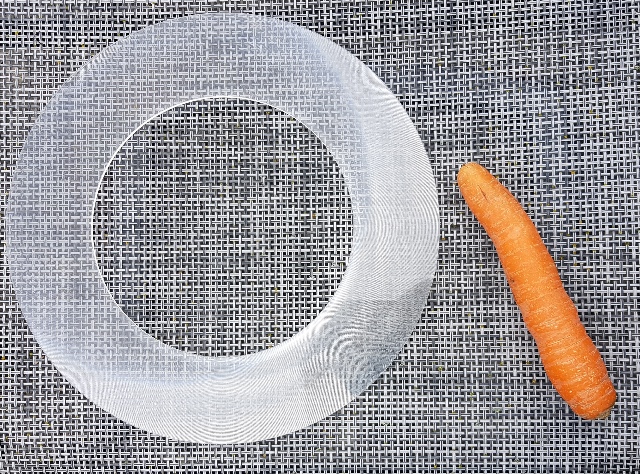 |
| Abb. 01-01-31: Das Wurzelende zeigt
tangential auf die Scheibe. mechanische Anströmung
von dort wäre CCW. (FB) |
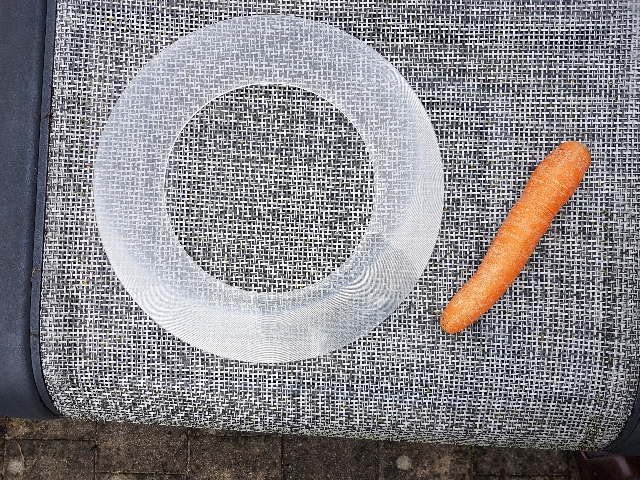 |
| Abb. 01-01-32: Das Wurzelende zeigt tangential auf die Scheibe. mechanische Anströmung von dort wäre CW. (FB) |
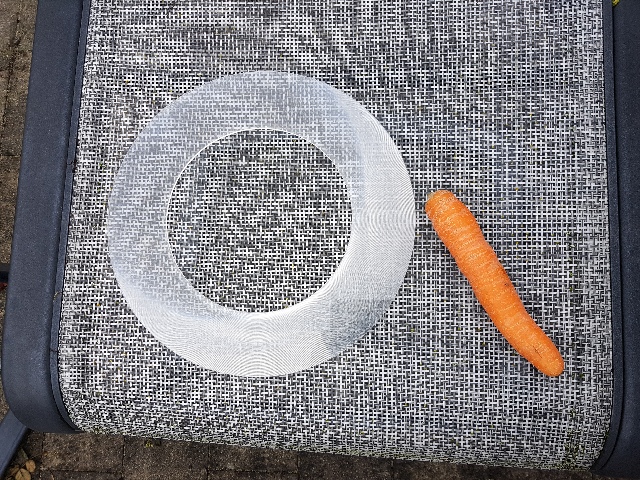 |
| Abb. 01-01-33: Das Ende mit dem Sproß zeigt tangential auf die Scheibe. Eine mechanische Anströmung wäre CCW (FB) |
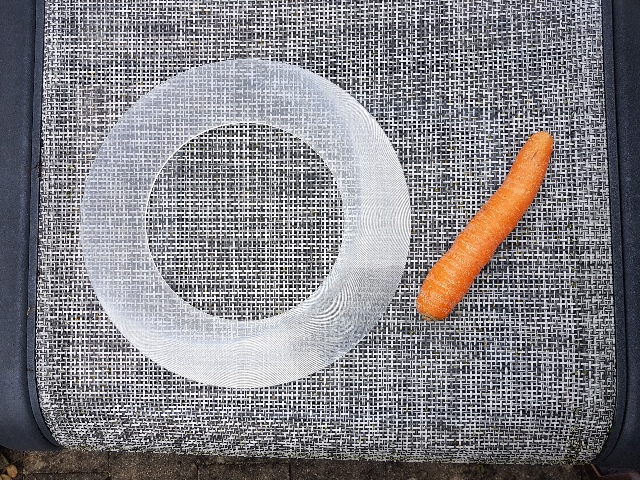 |
| Abb. 01-01-34: Das Ende mit dem Sproß zeigt tangential auf die Scheibe. Eine mechanische Anströmung wäre CW. (FB) |
1.1.2 Magnesiumstab steckt in Pertinax-Scheibe
05.03.2024
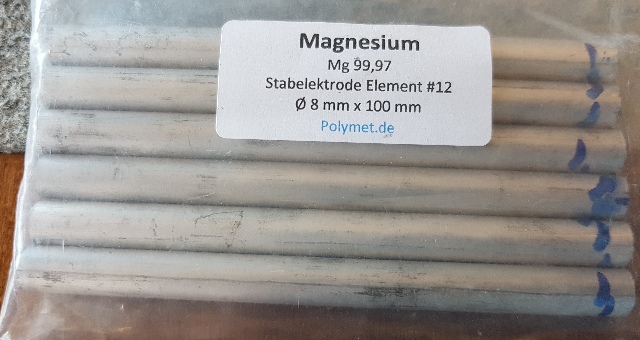 |
| Abb. 01-01-02-01: Magnesiumstäbe,
99.97 (FB) |
 |
| Abb. 01-01-02-02: 100 mm
lang, 8 mm Durchmesser (FB) |
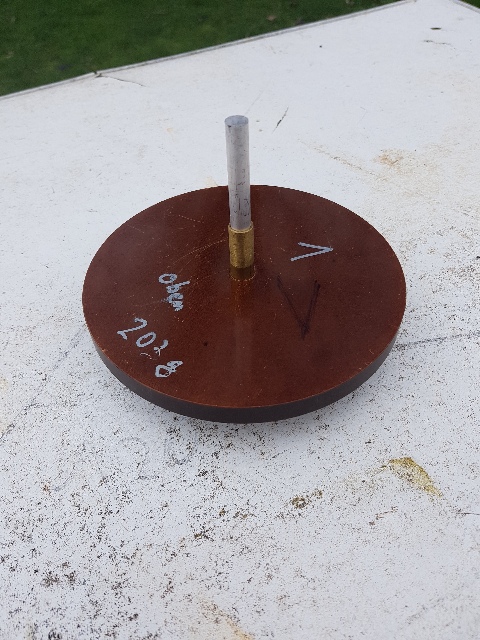 |
| Abb. 01-01-02-03: Magnesium 99.97
8 mm x 100 mm, Messing-Hülse und
Pertinax-Scheibe 20240305_100416 10:04:16 (FB) |
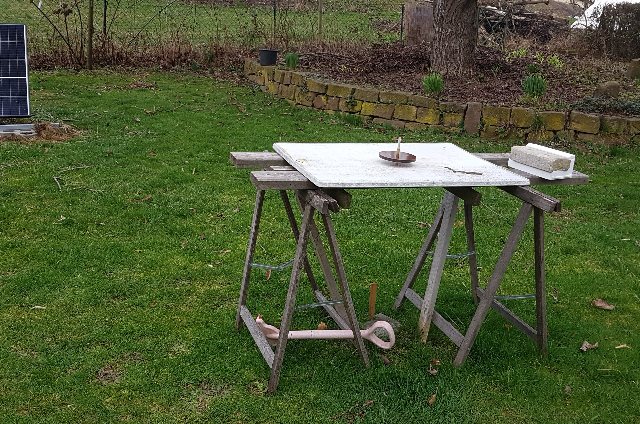 |
| Abb. 01-01-02-04:
20240305_100443 --- 10:04:43
30 Sekunden später Die Strukturen wachsen mit der Zeit an und haben eine große Reichweite (FB) |
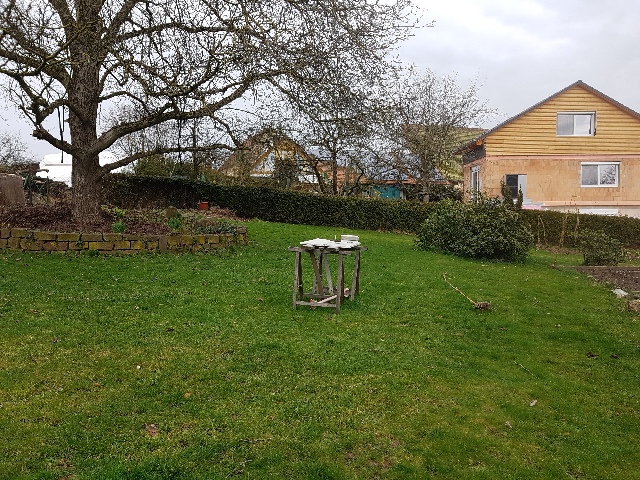 |
| Abb. 01-01-02-03:
20240305_100541 10:05:41
90 Sekunden später (FB) |
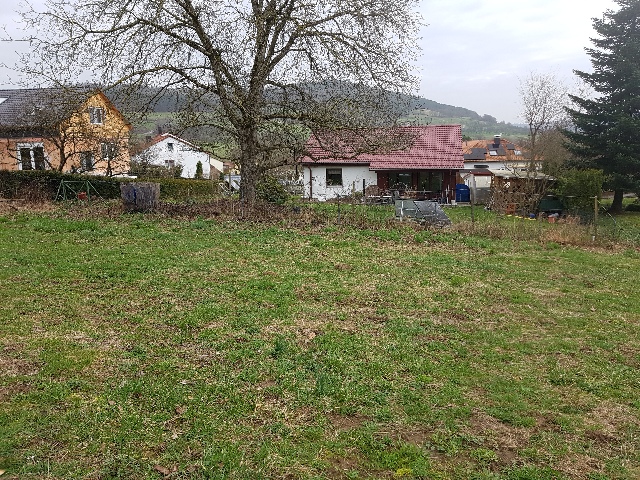 |
| Abb. 01-01-02-04:
20240305_100828 10:08:28
240 Sekunden später bis hierher reichen die Strukturen 20 m (FB) |
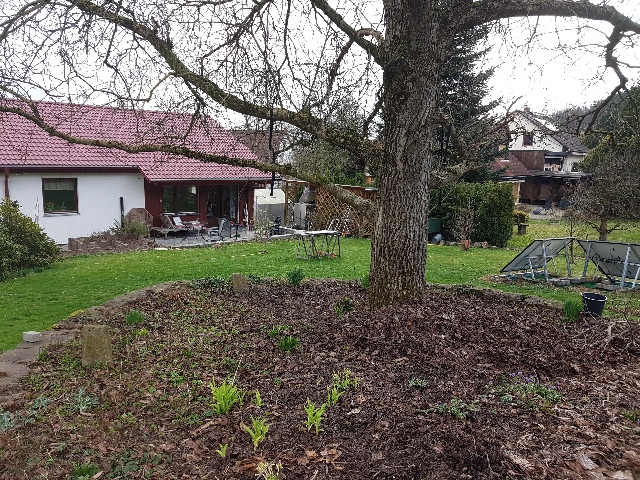 |
| Abb. 01-01-02-04:
20240305_100955 10:09:55
350 Sekunden später (FB) |
Opferanode für Boiler, Magnesium
20.03.2023
 |
Abb. 01-01-02-06:
aus ostwind.htm#kapitel-03-04 |
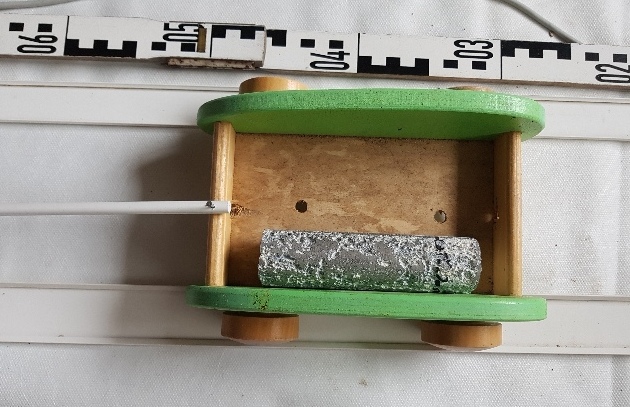 |
Abb. 01-01-02-07:
aus ostwind.htm#kapitel-05-02 |
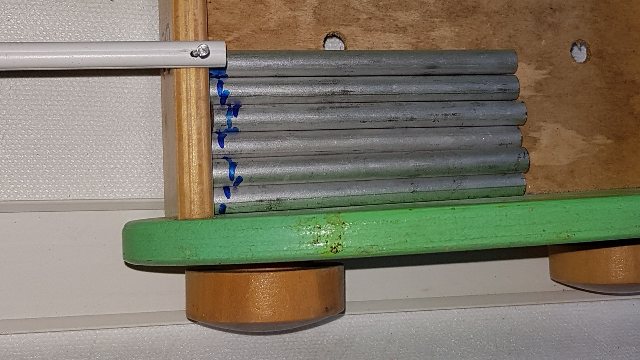 |
Abb. 01-01-02-08: Magnesium
99.97aus ostwind.htm#kapitel-05-02 |
 |
| Abb. 01-01-02-09: Magnesium (FB) |
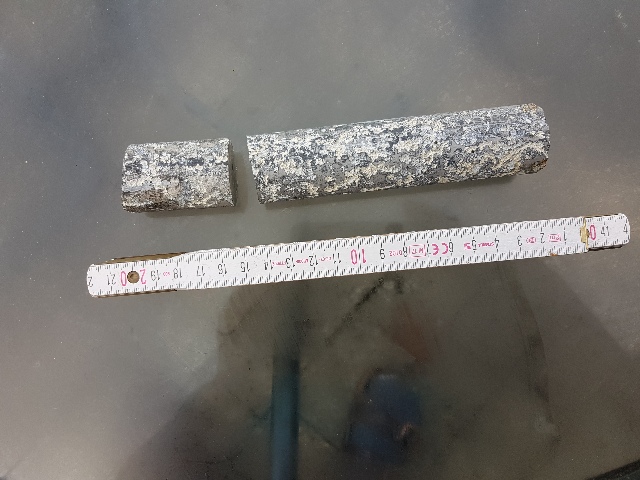 |
| Abb. 01-01-02-10: Magnesium (FB) |
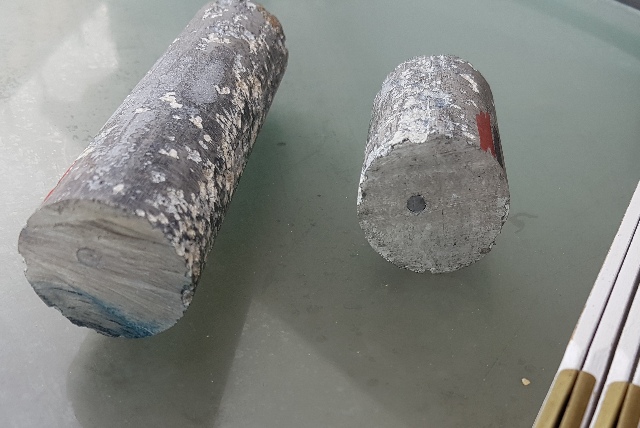 |
| Abb. 01-01-02-11: Magnesium,
eingeschmolzen ist ein Stab aus Eisen, Träger und
elektrischer Kontakt (FB) |
1.1.3 Weitere Metalle und Pertinax-Scheibe, Anregung eines Wirbels
01.02.2025
Bei allen Experimenten mit der Pertinax-Scheibe bildet sich eine Ringströmung in der Scheibe,
dazu gibt es eine gekoppelter Strömung in Achsenrichtung (Wirbel).
Je länger der Stab in der Scheibe steckt, um so intensiver wird die Struktur. Ihre Reichweite wächst ständig an.
Mechanisches Aufschlagen der Scheibe auf einen harten Untergrund löscht den Wirbel.
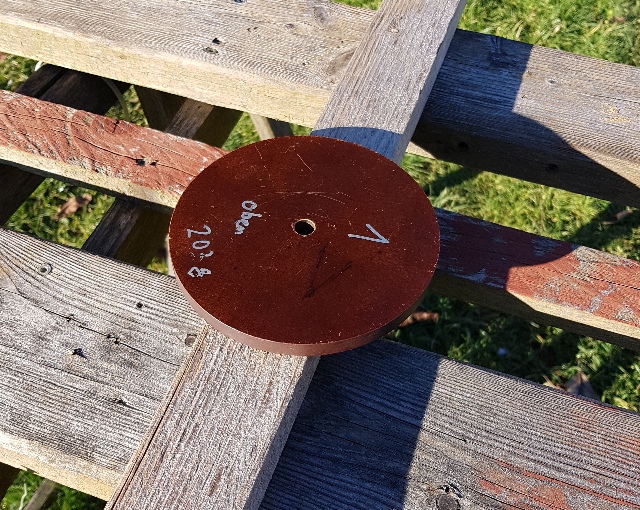 |
| Abb. 01-01-03-01: Scheibe
1 wie Experiment 05.03.2024
(Abb. 01-01-02-03) (FB) |
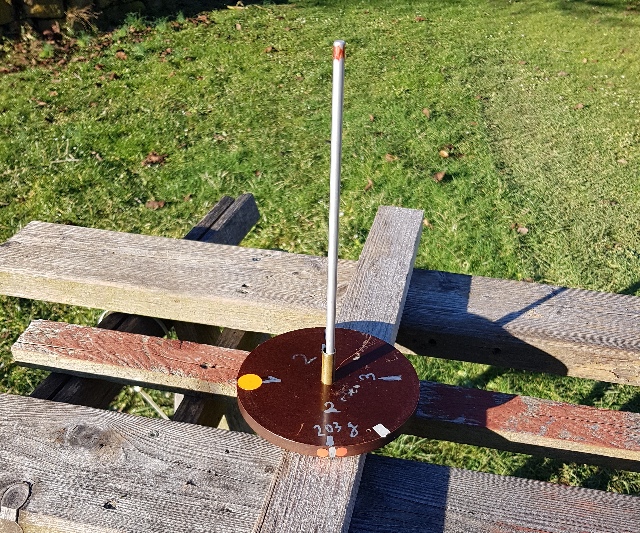 |
| Abb. 01-01-03-02: Scheibe 2 mit
Aluminiumstab 6 mm 250 mm lang, Ziehrichtung zeigt
nach oben, Scheibe beschriftet mit "oben" (FB) |
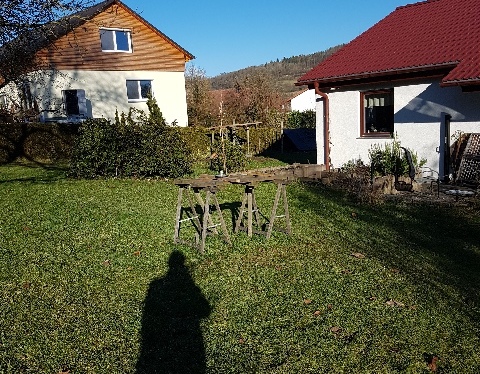 |
| Abb. 01-01-03-03: Schon nach einer
Minute hat sich eine große Struktur gebildet bis zur
Kamera (FB) |
 |
| Abb. 01-01-03-04: Weicher
Aluminiumdraht (DEKO), die beiden oberen sind
tordiert, CCW und CW, der untere ist unbehandelt. (FB) |
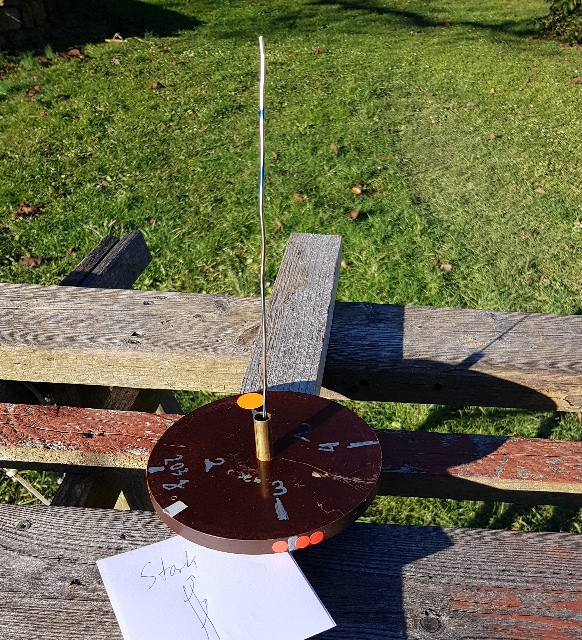 |
| Abb. 01-01-03-05: Draht zeigt nach
oben mit CCW (wie Skizze), es bildet sich
eine starke Struktur nach oben. 20250201_145551 14:55:51 (FB) |
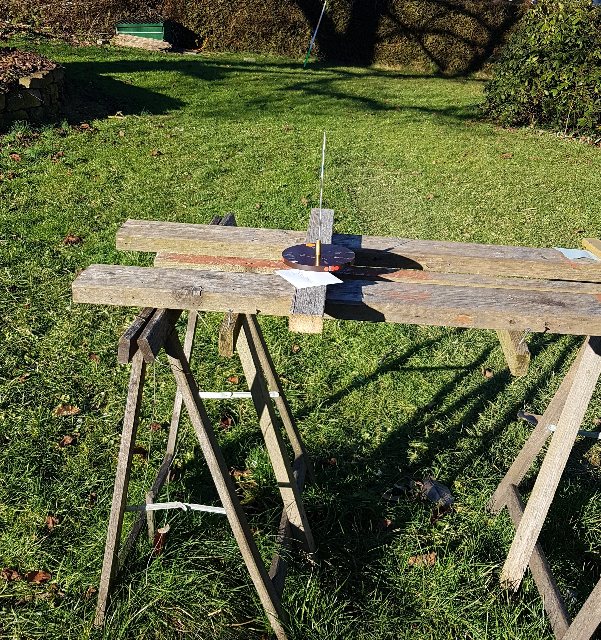 |
| Abb. 01-01-03-06: die Struktur reicht
mehrere Meter weit. 20250201_145602 14:56:02 (FB) |
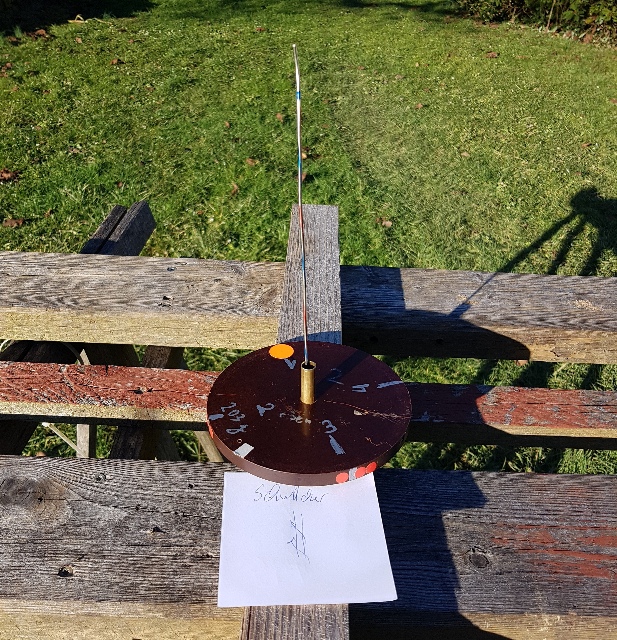 |
| Abb. 01-01-03-07: Draht zeigt CW
nach oben (wie Skizze), schwächere Struktur nach
oben. (FB) |
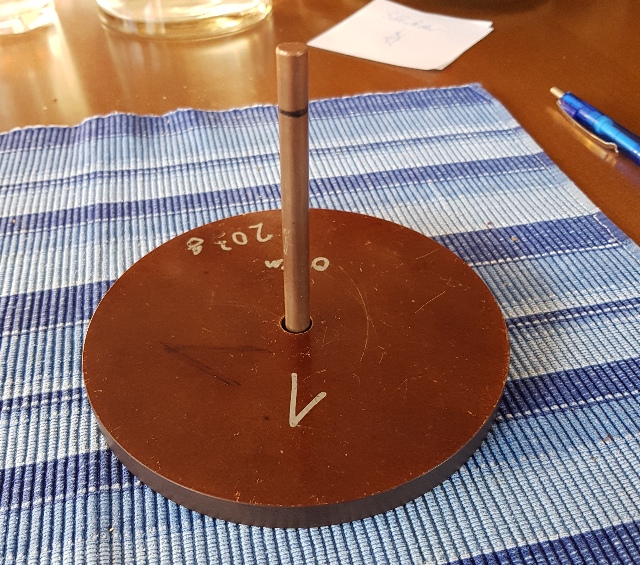 |
| Abb. 01-01-03-08: Kupferstab,
Ziehrichtung nach oben, Scheibe 1 "oben" (FB) |
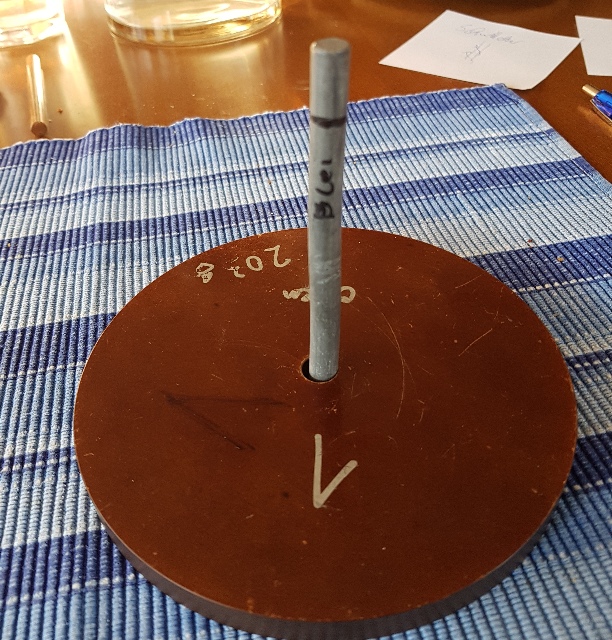 |
| Abb. 01-01-03-09: Blei, Ziehrichtung nach oben, Scheibe 1 "oben" (FB) |
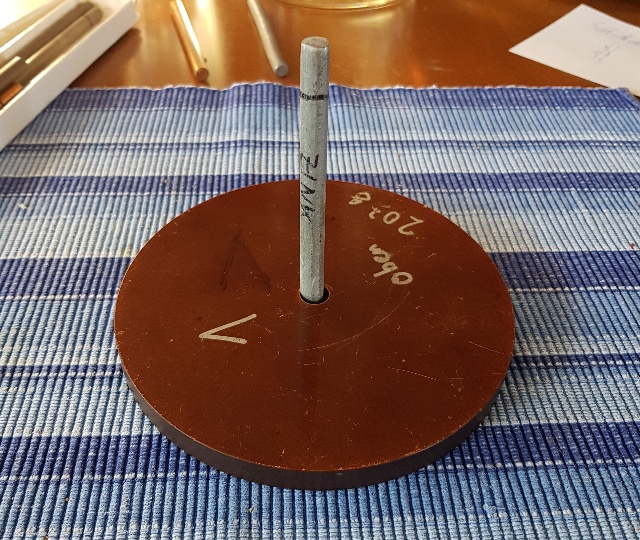 |
| Abb. 01-01-03-10: Zink, Ziehrichtung nach oben, Scheibe 1 "oben" (FB) |
 |
| Abb. 01-01-03-11: Nickel, Ziehrichtung nach oben, Scheibe 1 "oben" (FB) |
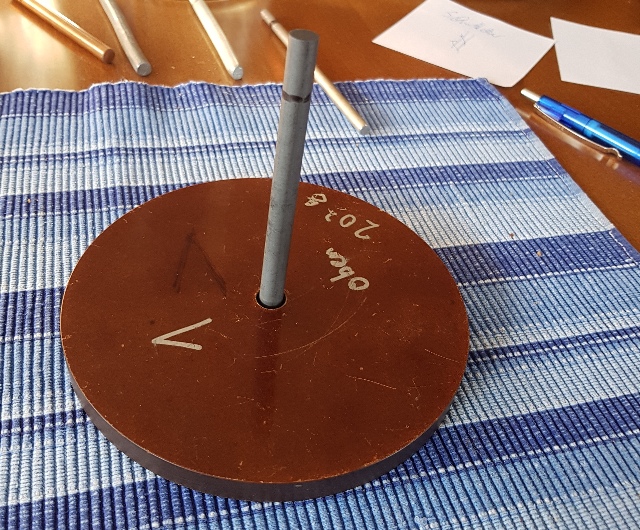 |
| Abb. 01-01-03-12: Graphit, Ziehrichtung nach oben, Scheibe 1 "oben" (FB) |
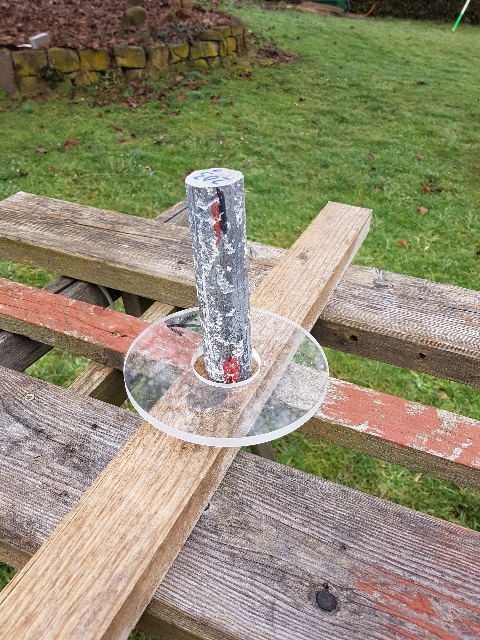 |
| Abb. 01-01-03-13: Magnesium
Opferanode und Plexiglas-Ring Bei dieser Anordnung entsteht eine ständig anwachsende Struktur (FB) |
1.2 Die Wirkung von Wismut bei Magneten, Batterien und anderen aktiven Körpern
The effect of bismuth at magnets, batteries and other active bodies.
wismut.htm#kapitel-02
Streicht man über den Körper und auch die Pole von a) Magneten oder b) Batterien,
dann werden die spürbaren oder "sichtbaren" Strukturen entfernt, bzw. stark verkleinert.
Diese Strukturen kann man wieder hervorrufen, wenn man Magnet bzw. Batterie "arbeiten" läßt:
Dazu
a) kontaktiert man kurzzeitig den Magneten mit einem Stück Eisen
b) schließt einen Widerstand an die Batterie an, so daß ein kleiner Strom fließt.
Es reicht schon, beide Kontakte gleichzeitig mit angefeuchteten Fingern zu berühren.
c) bei anderen aktiven Körpern hilft u.a. auch das Berühren (Abreiben) mit beiden Händen
Durch das Streichen hat sich das Wismut "angereichert". Die spürbaren Strukturen sind angewachsen.
Klopft man ein so angereicherte Stück auf eine mittelharte Unterlage, dann "fällt " ein Teil der Anreicherung herunter und bleibt auf der Unterlage "liegen".
If one strokes over the body and also the poles of a) magnets or b) batteries,
then the perceptible or "visible" structures are removed or strongly reduced.
These structures can be produced again, if one lets magnet or battery "work":
To do this
a) contact the magnet with a piece of iron for a short time
b) connect a resistor to the battery so that a small current flows.
It is sufficient to touch both contacts simultaneously with moistened fingers.
c) for other active bodies, touching (rubbing) with both hands helps, among other things.
The bismuth has been "enriched" by the stroking. The noticeable structures have grown.
If one taps such an enriched piece on a medium-hard base, then a part of the enrichment "falls down" and remains "lying" on the base.
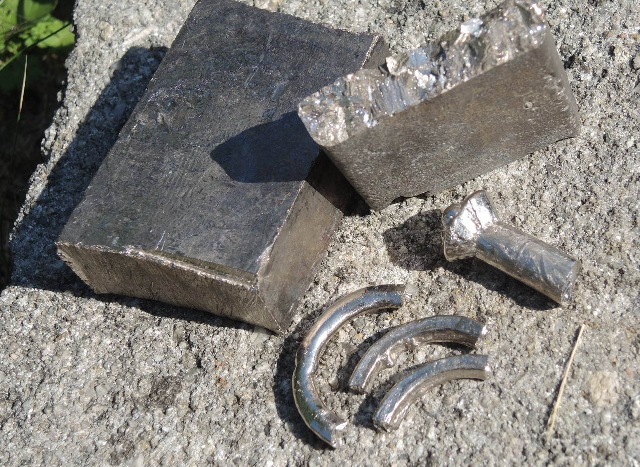 |
Abb. 01-02-01:aus wismut.htm |
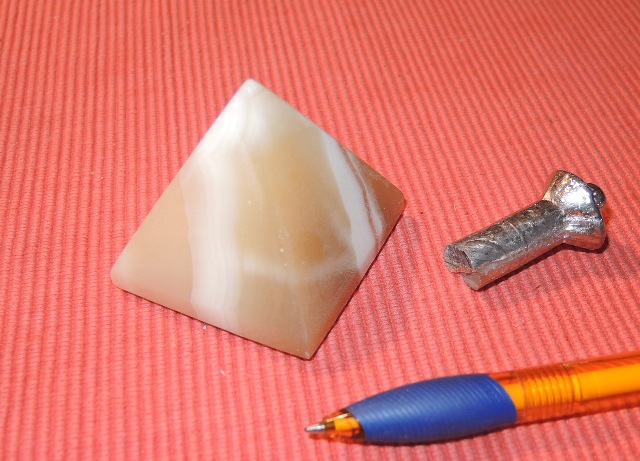 |
| Abb. 01-02-02: Steinpyramide,
mit Wismut "rasiert", spürbare Sturktur nur noch
minimal. Stone pyramid, "shaved" with bismuth, noticeable sturcture only minimal. (FB) aus wismut.htm |
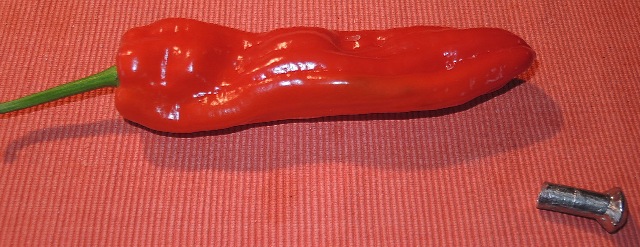 |
| Abb. 01-02-03: Paprikaschote, mit
Wismut "rasiert", spürbare Struktur ist nicht mehr
zu finden. Bell pepper, "shaved" with bismuth, noticeable structure is no longer found. (FB) |
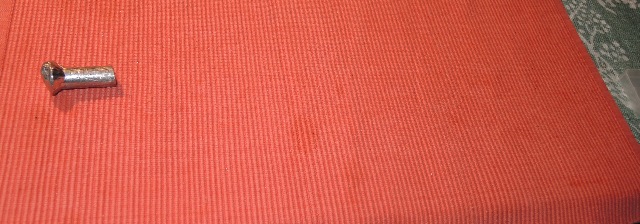 |
| Abb. 01-02-04: Wismut, die
Struktur reicht bis zum Bildrand Bismuth, the structure extends to the edge of the image (FB) |
 |
| Abb. 01-02-05: Wismut, nach dem
"Abschlagen" ist die Struktur nur noch sehr kurz Bismuth, after "knocking off" the structure is only very short (FB) |
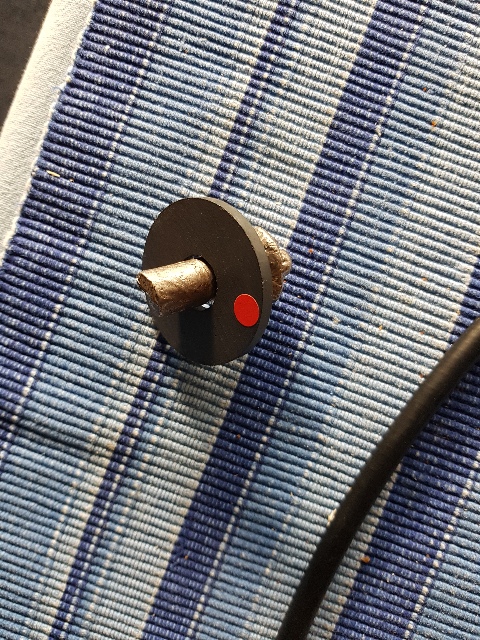 |
| Abb. 01-02-06: Wismut in
Ferrit-Ringmagnet (FB) |
1.3 Einfluß der Temperatur auf aktive Körper
Influence of temperature on active bodies
09.07.2019
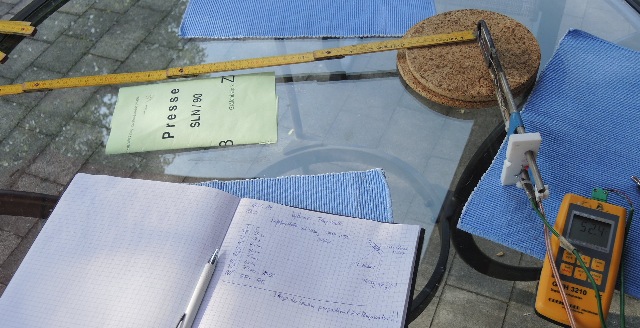 |
| Abb. 01-03-01: elektrisch beheizte
Kupferplatte mit Thermoelement, die spürbare
Struktur erstreckt sich in Richtung des Zollstocks.
10.07.2019 electrically heated copper plate with thermocouple, the noticeable structure extends in the direction of the folding rule. (FB) |
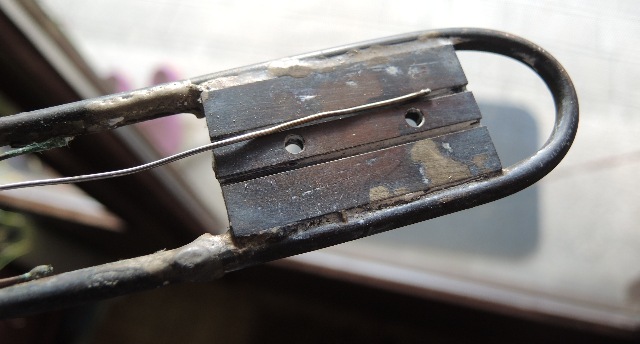 |
| Abb. 01-03-02: Kupferplatte 50
mm x 30 mm x 4 mm, außen hartgelötet ist ein Kupferrohr für Wasser/Luftkühlung, auf der Rückseite hart angelötet der Thermocoax-Heizdraht, die Nute auf der Vorderseite ist für das Thermocoax-Thermoelement. Bei Heizung mit Gleichstrom 13,6 V 6 A Ladegerät -> 270° outside hard soldered is a copper tube for water/air cooling, on the back side hard soldered is the Thermocoax heating wire, the groove on the front side is for the Thermocoax thermocouple. When heating with direct current 13.6 V 6 A charger -> 270°. (FB) |
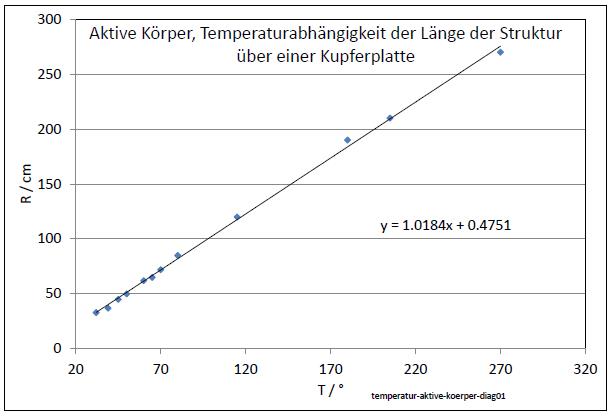 |
| Abb. 01-03-03: Die Länge der Struktur
wächst bei steigender Temperatur mit etwa 1 cm /
°. (Keulenorbital? aus Abb. 01-01-24) The length of the structure grows with increasing temperature with about 1 cm / °. (FB) |
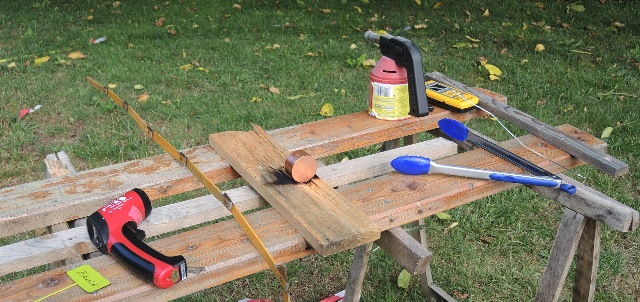 |
| Abb. 01-03-04: 14.07.2019 Kupferzylinder 471 g, Infrarot-Thermometer, Gasbrenner und Thermoelement mit Anzeigegerät. 14.07.2019 Die Achse des Zylinders ist horizontal ausgerichtet. Die zu untersuchende spürbare Struktur dehnt sich in Richtung dieser Achse aus. Es ist ein Keulenorbital wie in Abb. 01-01-24. Copper cylinder 471 g, infrared thermometer, gas burner and thermocouple with indicator. 14.07.2019 The axis of the cylinder is oriented horizontally. The sensible structure under investigation expands in the direction of this axis. It is a club orbital as in Fig. 01-01-24. (FB) |
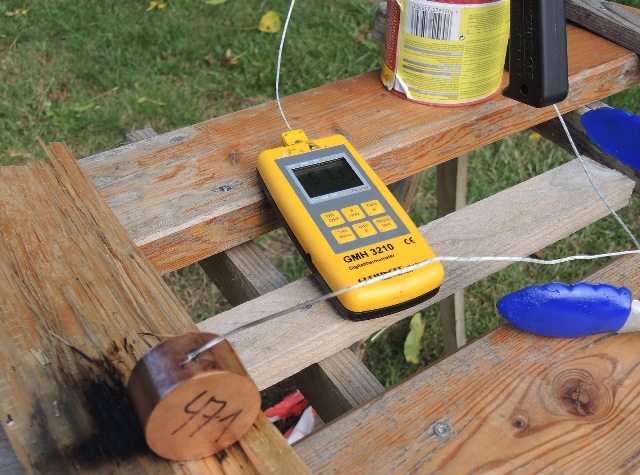 |
| Abb. 01-03-05: Im Zylinder ist eine
kleine Bohrung, in der das Thermoelement steckt. There is a small hole in the cylinder where the thermocouple is located. (FB) |
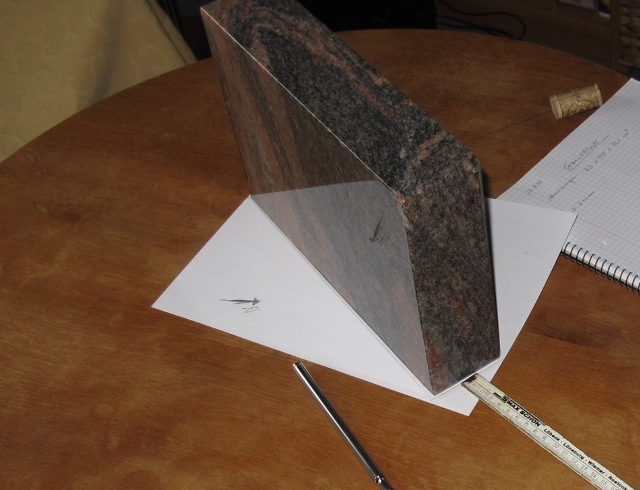 |
| Abb. 01-03-06: 24.07.2011 Die "Strahlung" dieser Struktur dringt auch durch diesen Granitklotz hindurch. Auf der Rückseite ist sie dann aufgefächert in einen äußeren und einen inneren Teil. etwa so wie in Abb. 01-01-24 der obere gelbe und rote Teil ? 20.07.2019 Ändert man den Auftreffwinkel des Bündels, so folgt auch der durchgehende "Strahl" bzw. die Struktur. The "radiation" of this structure also penetrates through this granite block. On the backside it is then fanned out into an outer and an inner part. approximately like in fig. 01-01-24 the upper yellow and red part ? 20.07.2019 If one changes the angle of impact of the bundle, the continuous "beam" or structure also follows. (FB) |
Ähnliches Verhalten bei Sonnenlicht
Similar behavior under sunlight
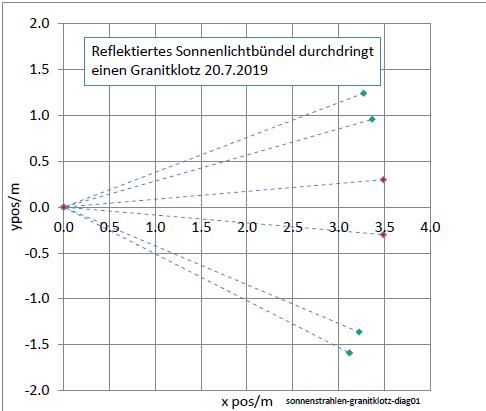 |
| Abb. 01-03-07: im Mittelpunkt vom
Meßkreis mit Radius 3,5 m stand der Granitklotz. Mit einem Spiegel wurde ein Bündel vom Sonnenlicht auf den Klotz gelenkt in Richtung Osten. (im Diagramm rechts). Es gibt drei Bündel: Mitte und jeweils links und rechts davon bei rund 20° 20.07.2019 In the center of the measuring circle with radius 3.5 m stood the granite block. With a mirror a bundle of the sunlight was directed on the block in the direction of the east. (in the diagram on the right). There are three bundles: center and each left and right of it at about 20°. 20.07.2019 (FB) |
| Die Winkel für die Aufspaltung hängt
beim Granitklotz von der Breite des Objektes ab. Der Quader hat drei unterschiedliche Flächen. Trifft das Lichtbündel auf die breite Seite: große Aufspaltung, mittlere Seite: mittlere Aufspaltung und bei der schmalsten Seite: kleine Aufspaltung. - >> Kantenstrahlung ? The angles for the splitting of the granite block depend on the width of the object. The cuboid has three different surfaces. If the light bundle hits the wide side: large splitting, the middle side: medium splitting and the narrowest side: small splitting. - >> Edge radiation ? |
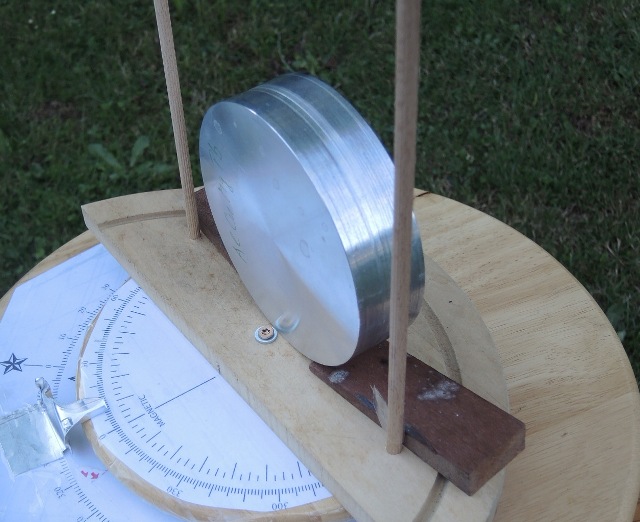 |
| Abb. 01-03-08: 13.07.2017 Gleiches Verhalten gibt es bei der dicken Aluminiumscheibe mit 1161 g. 20.07.2019 The same behavior occurs with the thick aluminum screen at 1161 g. (FB) |
2. Einfache Versuchsobjekte für jederman, Obst und Gemüse
Simple experimental objects for everyone, fruits and vegetables
Die hier vorgestellten Eigenschaften hängen von äußeren Einflüssen ab. Es gibt einige Tage im Jahr,
bei denen sich die Eigenschaften umpolen.
raunaechte.htm#kapitel-02
 |
Abb. 02-00: Ausnahmen der
Regel, normalerweise ist die Struktur an der
Blütenseite (links) länger als an der Wurzelseite.aus raunaechte.htm#kapitel-02 |
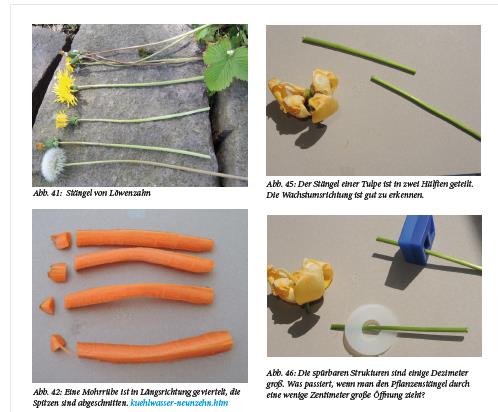 |
| Abb. 02-01: aus Seite 15
wbm-2016-teil02-high.pdf |
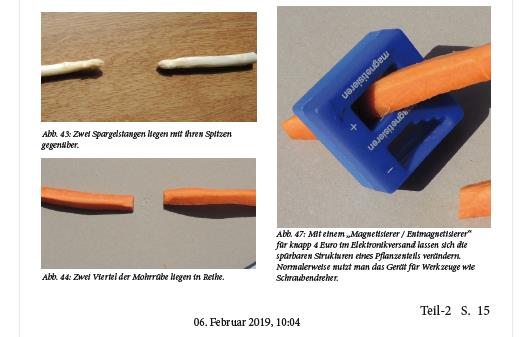 |
| Abb. 02-02: aus Seite 15 wbm-2016-teil02-high.pdf |
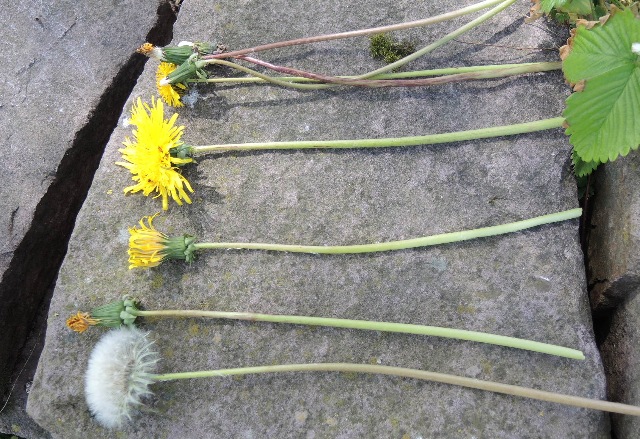 |
| Abb. 02-02a: |
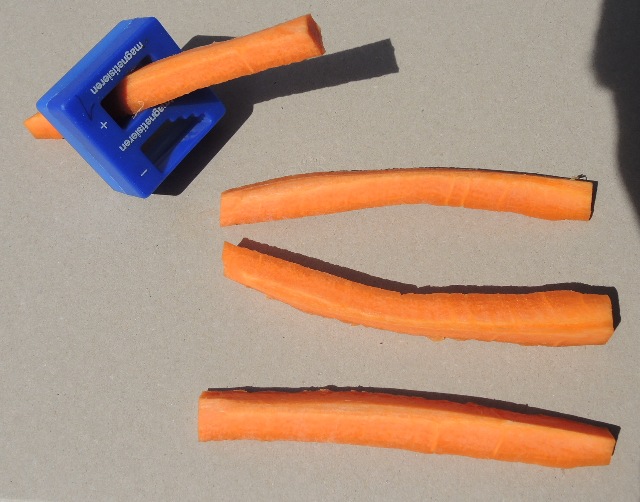 |
| Abb. 02-02b: |
 |
| Abb. 02-03: Grüne Gurke, die
Blütenseite ist links Green cucumber, the flower side is left (FB) |
 |
| Abb. 02-04: Zwei
Bananen, beide Blütenseiten gegenüber, aus diesen
Enden "strömt" etwas heraus. Es gibt dort Wirbel. Two bananas, both sides of the flower opposite, from these ends something "flows" out. There are swirls there. (FB) |
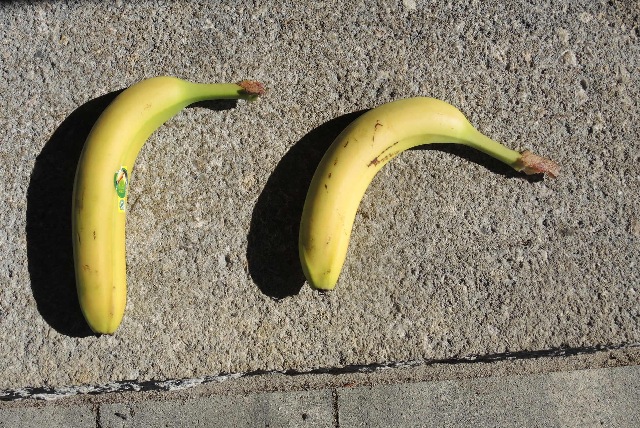 |
| Abb. 02-05: zwei
Bananen, parallel, nach unten "strömt" etwas heraus,
von rechts wird am Stengel etwas "angesaugt". two bananas, parallel, to the bottom something "flows" out, from the right something is "sucked" on the stem. (FB) |
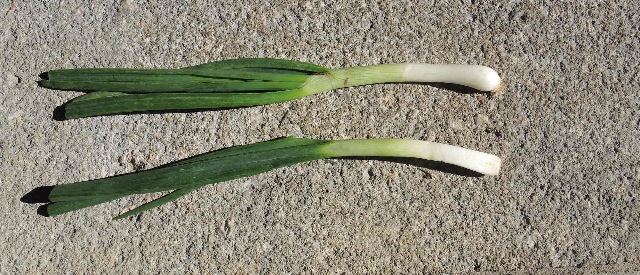 |
| Abb. 02-06: zwei Lauchstangen,
parallel, links "strömt" etwas heraus, rechts an der
Wurzel wird etwas "angesaugt". two leeks, parallel, on the left "flows out" something, on the right at the root is "sucked" something. (FB) |
 |
| Abb. 02-07: Die Wurzelenden sind
entgegengesetzt, an beiden Enden wird etwas
"angesaugt". The root ends are opposite, something is "sucked" at both ends.(FB) |
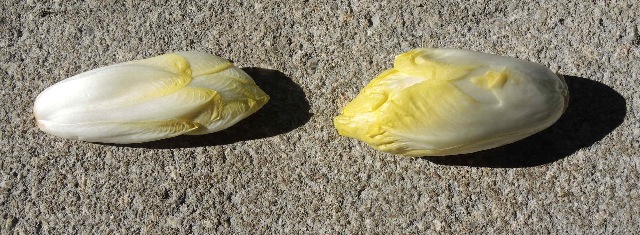 |
| Abb. 02-08: Chicorée, Spitzen
gegeneinander, aus beiden Spitzen "strömt" etwas
heraus. Es gibt Wirbel. Chicory, tips against each other, something "flows" out of both tips. There are swirls. (FB) |
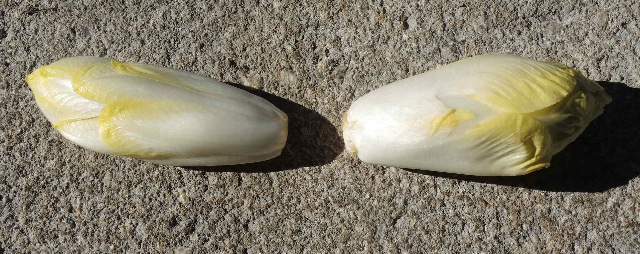 |
| Abb. 02-09: Chicorée, Wurzeln
gegeneinander, an beiden Enden wird etwas
"angesaugt". Chicory, roots against each other, at both ends is "sucked" a little. (FB) |
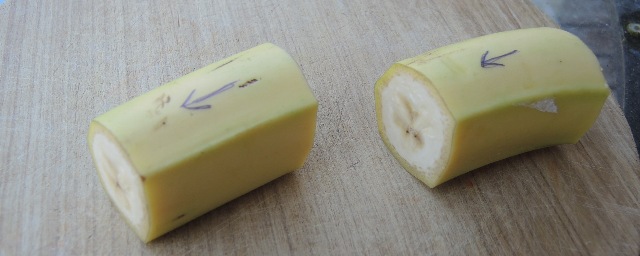 |
| Abb. 02-10: zwei Bananenstücke,
gleiche Ausrichtung. Im Zwischenbereich ist es
vergleichsweise "ruhig". vom rechten Stück "strömt"
etwas heraus und wird vom linken Stück "angesaugt". Two banana pieces, same orientation. In the intermediate area, it is comparatively "quiet". Something "flows out" from the right piece and is "sucked in" by the left piece. (FB) |
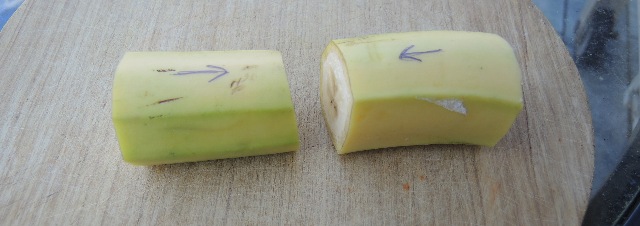 |
| Abb. 02-11: zwei Bananenstücke, die
Blütenseiten entgegengesetzt, in der Bildmitte
"strömt" aus beiden etwas heraus, es gibt Wirbel two pieces of banana, the sides of the flower opposite, in the center of the picture something "flows" out of both, there are swirls(FB) |
 |
| Abb. 02-12: zwei Bananenstücke, die
Stengelseiten entgegengesetzt, in der Bildmitte
"saugen" beide etwas ab. two pieces of banana, the stem sides opposite, in the center of the picture both "suck" something. (FB) |
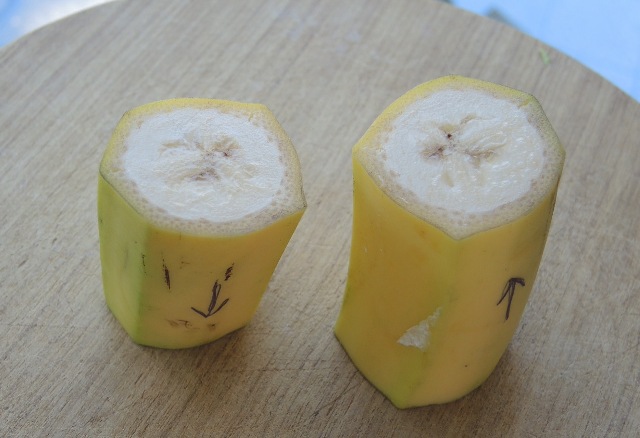 |
| Abb. 02-13: zwei Bananenstücke,
Stengelseite und Blütenseite nebeneinander das was vom rechten Stück oben "herauskommt", wird vom linken Stück oben "angesaugt". two pieces of banana, stem side and flower side next to each other. what "comes out" from the right piece at the top, is "sucked" from the left piece at the top.(FB) |
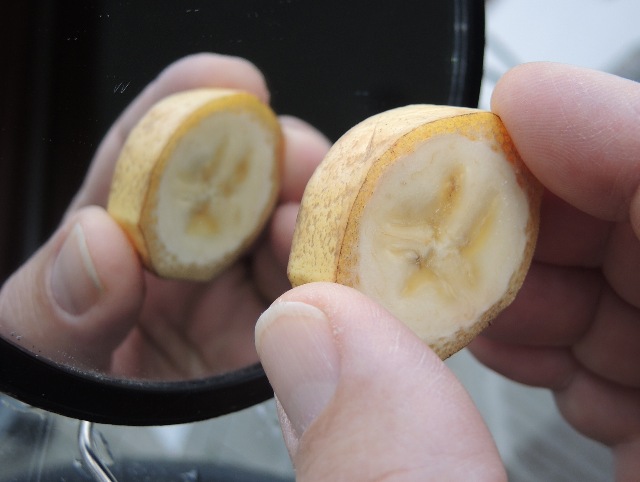 |
| Abb. 02-14: Bananenstück und
Spiegelbild der Rückseite. beim Spiegelbild wird "angesaugt", bei der Vorderseite "kommt etwas heraus". Banana piece and mirror image of the reverse side. with the mirror image is "sucked in", with the front side "something comes out". (FB) |
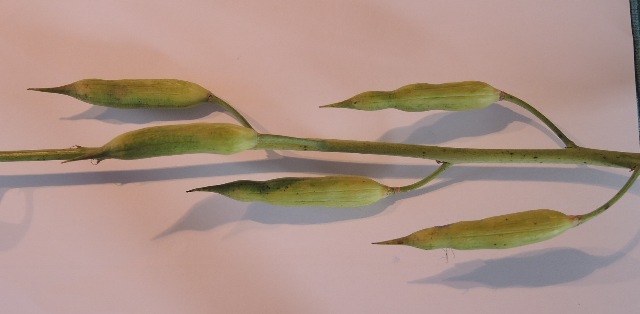 |
| Abb. 02-15: Schoten eines
Gründüngers, sehr aktive Spitzen
Pods of a green manure, very active tips (FB) |
weitere Zusammenstellung von geschlossenen Ringen mit aktiven Elementen: kuehlwasser-neunzehn.htm#kapitel-02-03
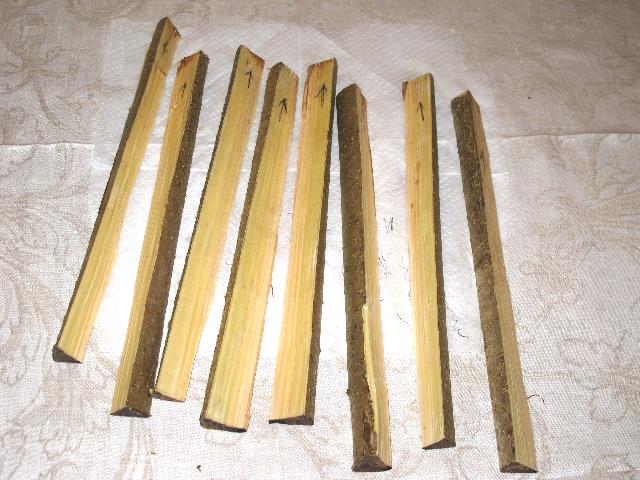 |
Abb.02-16:aus: kuehlwasser-neunzehn.htm |
 |
Abb. 02-17:aus: steinkreise-08.htm |
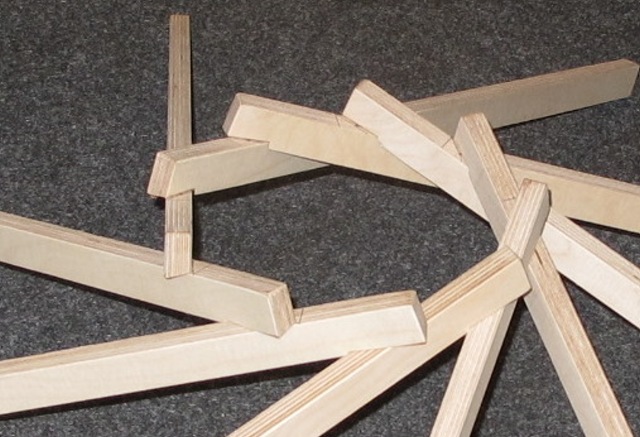 |
| Abb. 02-18: 06.10.2013
eine Seite der Hölzer ist etwas angeschrägt.
Möglicherweise ist damit eine
"Wachtumsrichtung" dauerhaft markiert. one side of the timbers is slightly beveled. Possibly, this permanently marks a "direction of growth". aus formstrahler.htm#kapitel-03-01 |
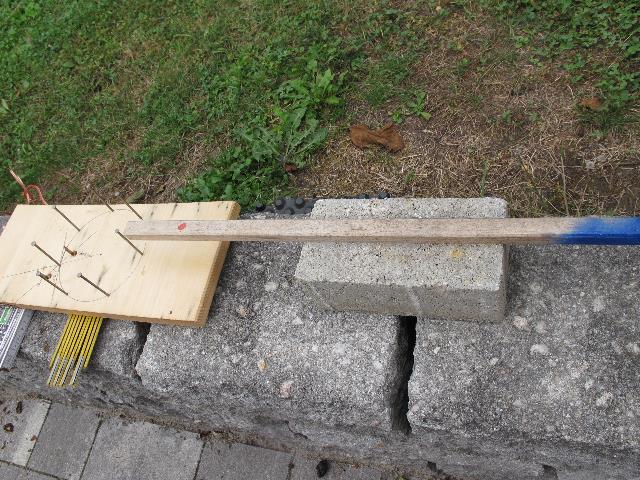 |
Abb. 02-19:aus steinkreise-06.htm#kapitel06-6 |
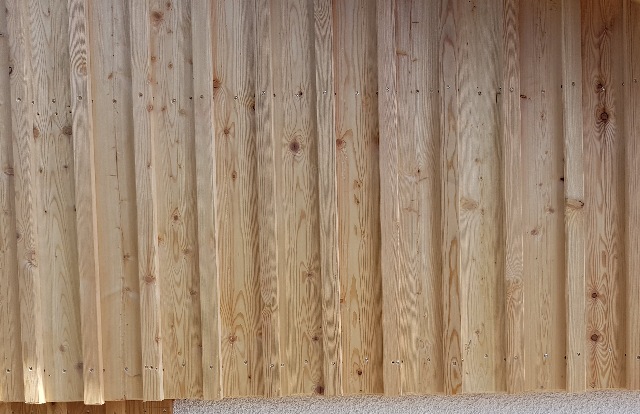 |
| Abb. 02-20: Fassade mit Lärchenholz,
alle Hölzer sind mit gleicher Wachstumsrichtung
(Wurzel nach unten) angebracht. Facade with larch wood, all woods are attached with the same direction of growth (root down). (FB) |
 |
Abb. 02-21: Aluminium Stäbe mit
gleicher Ausrichtungaus sandrohr.htm#kapitel-16 |
3. Erweiterte Experimente, oszillierende Bewegung
Advanced experiments, oscillating movement
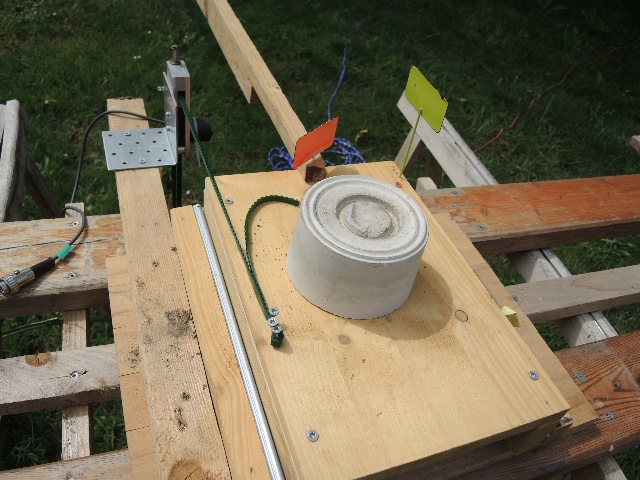 |
| Abb. 03-01: 08.06.2019
Gipsklotz, Die Holzplatte wird sehr langsam hin und
her geschoben. The wooden plate is pushed back and forth very slowly. aus bewegte-materie-oszillierend.htm#kapitel-08-02 |
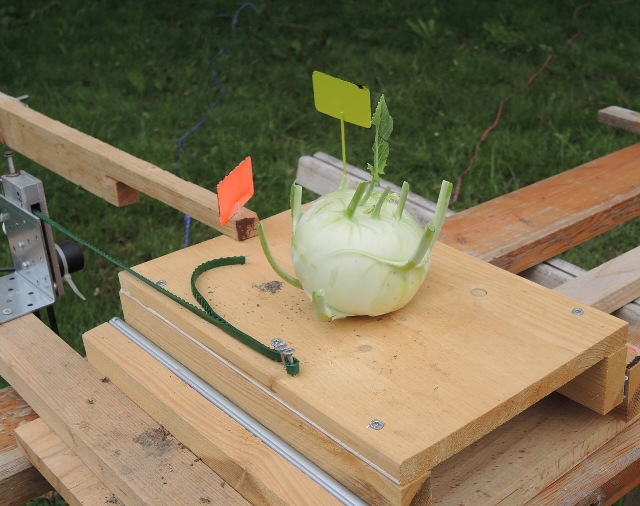 |
Abb. 03-02:
aus bewegte-materie-oszillierend.htm#kapitel-08-02 |
 |
Abb. 03-03:
aus bewegte-materie-oszillierend.htm#kapitel-08-02 |
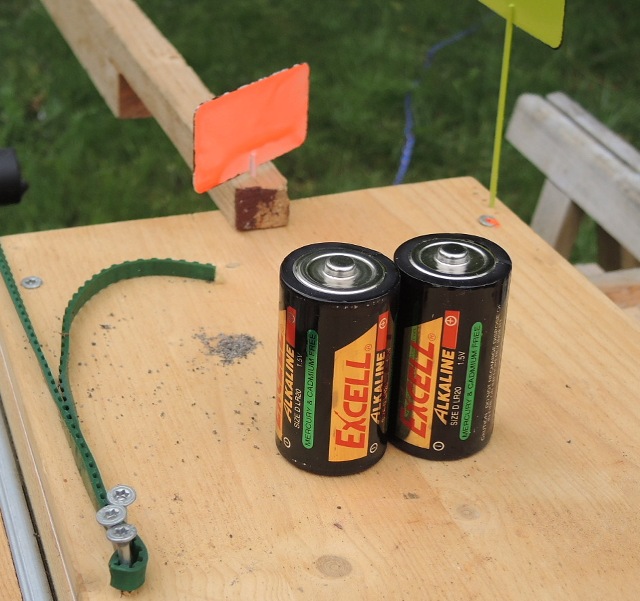 |
Abb. 03-04:aus bewegte-materie-oszillierend.htm#kapitel-08-02 |
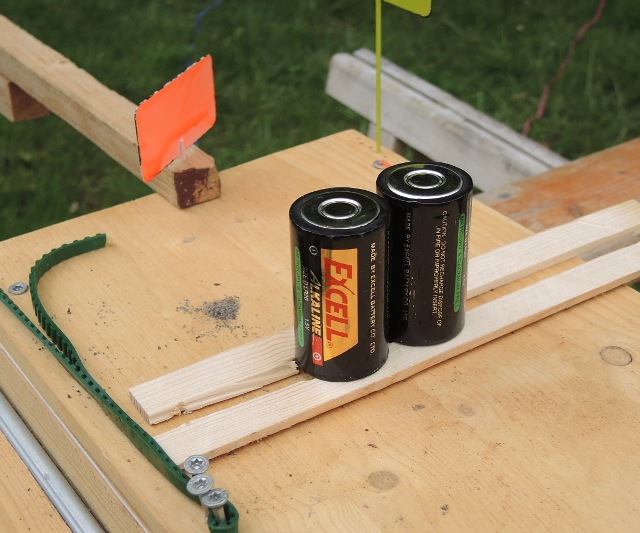 |
Abb. 03-04a: aus bewegte-materie-oszillierend.htm#kapitel-08-02 |
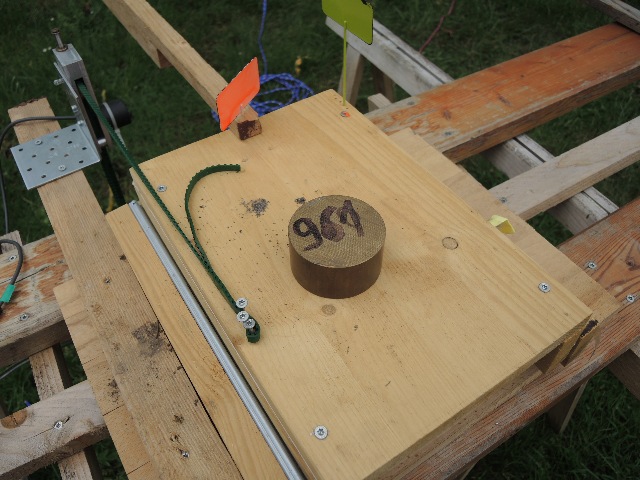 |
| Abb. 03-05: Messingzylinder,
Schrift (Ziehrichtung) nach oben Brass cylinder, writing (drawing direction) upwards aus bewegte-materie-oszillierend.htm#kapitel-08-02 |
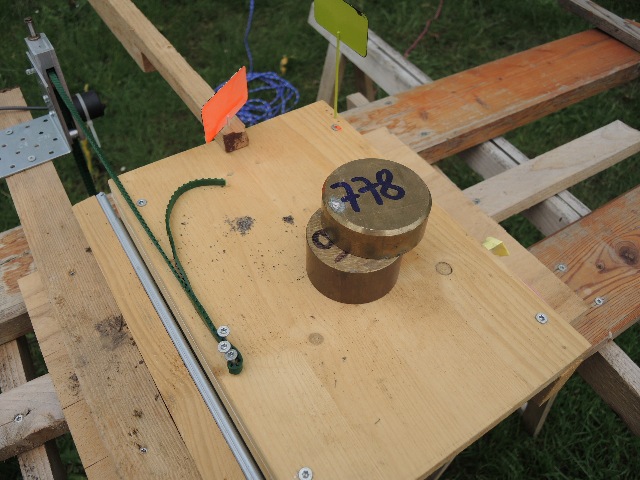 |
| Abb. 03-06: zwei
Messingzylinder, Schrift (Ziehrichtung) nach oben two brass cylinders, writing (drawing direction) upwards aus bewegte-materie-oszillierend.htm#kapitel-08-02 |
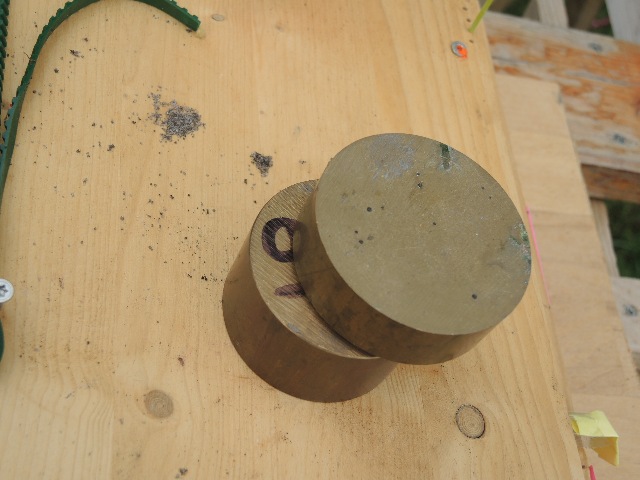 |
| Abb. 03-07: Messingzylinder, Schrift
(Ziehrichtung) entgegengesetzt Brass cylinder, writing (drawing direction) opposite aus bewegte-materie-oszillierend.htm#kapitel-08-02 |
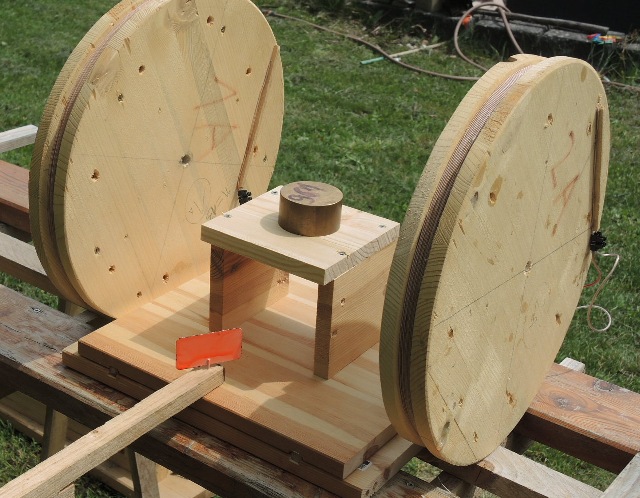 |
| Abb. 03-08: 11.06.2019 Bewegung
innerhalb des Magnetfeldes einer Helmholtzspule Das Feld ist extrem klein, es fließt ein Strom von einigen picoAmpere. Movement within the magnetic field of a Helmholtz coil. The field is extremely small, a current of a few picoAmperes flows. aus bewegte-materie-oszillierend.htm#kapitel-08-04 |
4. Anregung durch oszillierende Bewegung
Excitation by oscillating movement
 |
Abb. 04-01:aus bewegte-materie-oszillierend.htm#kapitel-11 |
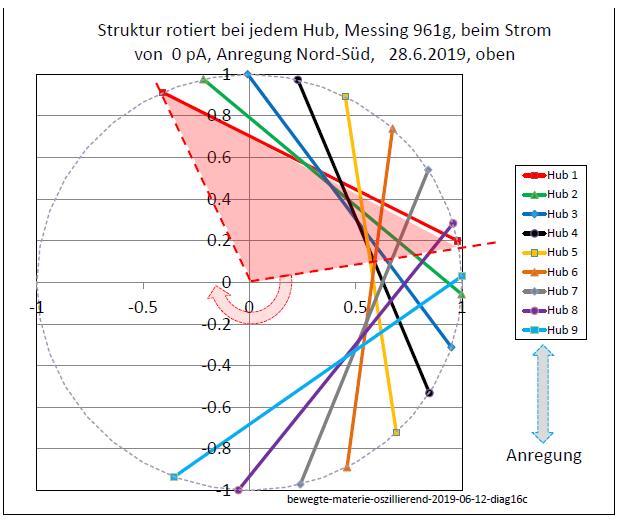 |
Abb. 04-02:aus bewegte-materie-oszillierend.htm#kapitel-11 |
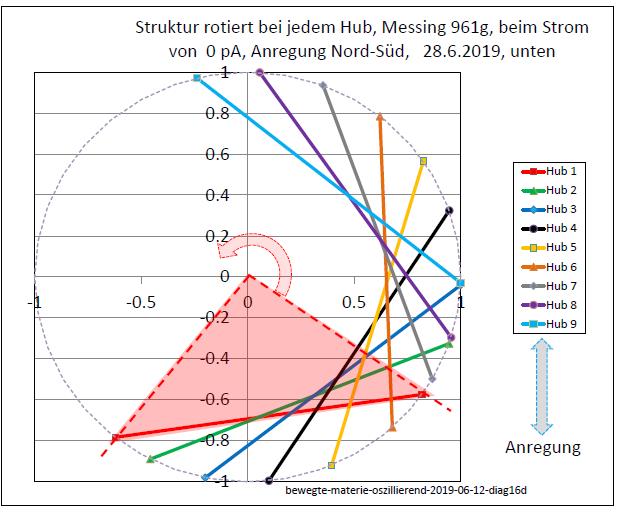 |
Abb. 04-03:aus bewegte-materie-oszillierend.htm#kapitel-11 |
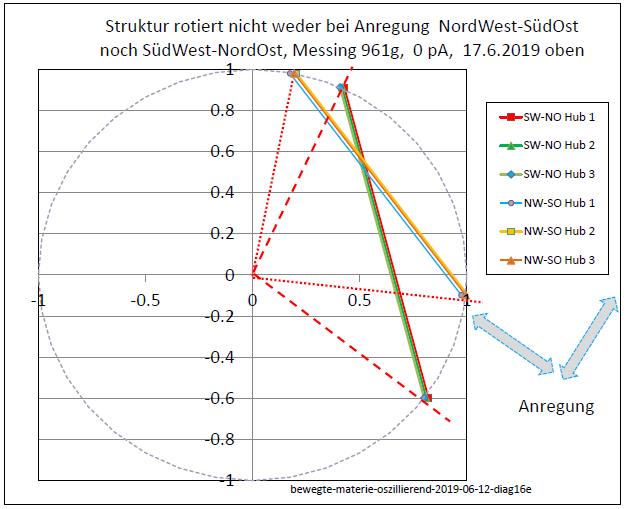 |
Abb. 04-04:aus bewegte-materie-oszillierend.htm#kapitel-11 |
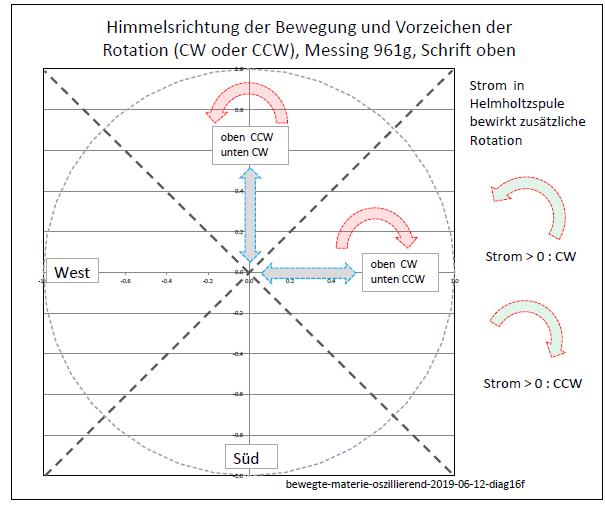 |
Abb. 04-05:aus bewegte-materie-oszillierend.htm#kapitel-11 |
mit Magnetfeld
With magnetic field
 |
Abb. 04-06:aus bewegte-materie-oszillierend.htm#kapitel-11 |
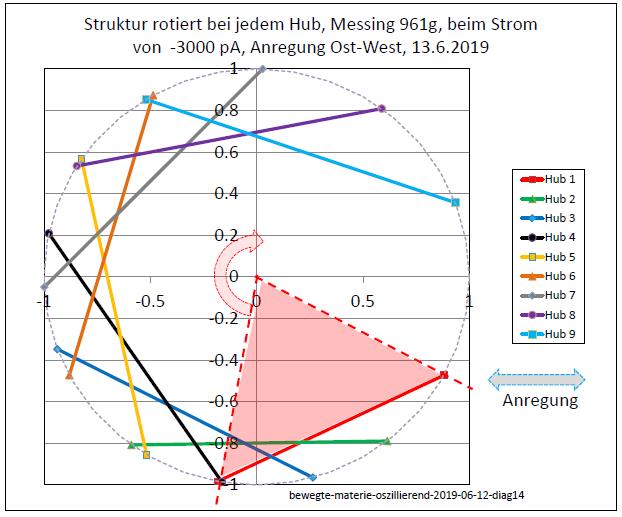 |
Abb. 04-07:
aus bewegte-materie-oszillierend.htm#kapitel-11 |
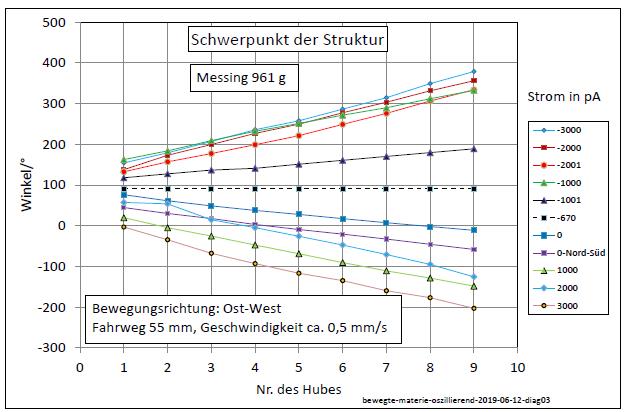 |
Abb. 04-08:aus bewegte-materie-oszillierend.htm#kapitel-11 |
Mechanisches Modell (Versuch zur Deutung)
Mechanical model (attempt at interpretation)
Beobachtung bei den spürbaren Strukturen:
- Bei jedem Hub dreht sich die Ausrichtung der Struktur um einen festen Betrag weiter (je nach Material positiv oder negativ).
- Mit einem zusätzlichen Magnetfeld läßt sich die Schrittweite der Drehung bei jedem Hub vergrößern bzw. auch umkehren.
- Bei passendem Feld läßt sich so eine anfängliche Drehung kompensieren. Die Struktur verschiebt sich nicht bei jedem Hub.
Im Inneren wird eine eiförmige Struktur (graue Ellipse) periodisch hin- und her bewegt.
Außen gibt es eine andere Struktur mit gekoppelten rotierenden Teilen auf einem gemeinsamen Träger (jeweils zwei Zahnräder, rot, blau gelb und grün). Diese Zahnräder sollen sich ständig drehen.
Wenn das eine Zahnrad CW dreht, dann hat das andere die umgekehrte Richtung CCW.
Wird beim Verschieben der inneren Struktur eines der Zahnräder kurzzeitig berührt, dann wird das Zahnradpaar und damit der Träger seitlich um ein Stück verschoben und zwar jedesmal etwa um das gleichen Betrag.
Die Richtung der Verschiebung hängt von der Schiefstellung der grauen Ellipse ab.
Für das Zahnradpaar auf der Gegenseite (unten im Bild) gibt es bei der Rückbewegung die gleiche Verschiebung.
Bei der linken Skizze erfolgt die Verschiebung CW, bei der rechten CCW.
In der mittleren Skizze berühren beide Zahnräder die Ellipse, die Wirkung kompensiert sich und es gibt keine Verschiebung.
Dieses Modell hat die vorgenannten Eigenschaften nur dann, wenn die Verschiebung im Vergleich zum Durchmesser der Zahnräder klein ist.
----------------
zweite Abbildung:
Wird das System mit den Zahnrädern auf dem Träger um einen Zahnraddurchmesser verdreht, dann läßt sich die Wirkung umkehren.
Observation for the perceptible structures:
- With each stroke, the orientation of the structure continues to rotate by a fixed amount (positive or negative, depending on the material).
- With an additional magnetic field, the step size of the rotation can be increased or reversed with each stroke.
- With a suitable field, an initial rotation can be compensated. The structure does not shift with each stroke.
Inside, an egg-shaped structure (gray ellipse) is periodically moved back and forth.
Outside, there is another structure with coupled rotating parts on a common support (two gear wheels each, red, blue yellow and green). These gears are supposed to rotate continuously.
If one gear is rotating CW, the other one has the opposite direction CCW.
If one of the gears is touched for a short time while shifting the inner structure, then the pair of gears and thus the beam is shifted sideways by a bit, each time by about the same amount.
The direction of the displacement depends on the skew of the gray ellipse.
For the gear pair on the opposite side (at the bottom of the picture) there is the same displacement during the backward movement.
In the left sketch the displacement is CW, in the right sketch CCW.
In the middle sketch, both gears touch the ellipse, the effect compensates and there is no displacement.
This model has the above properties only when the displacement is small compared to the diameter of the gears.
----------------
second figure:
If the system with the gears on the carrier is rotated by one gear diameter, then the effect can be reversed.
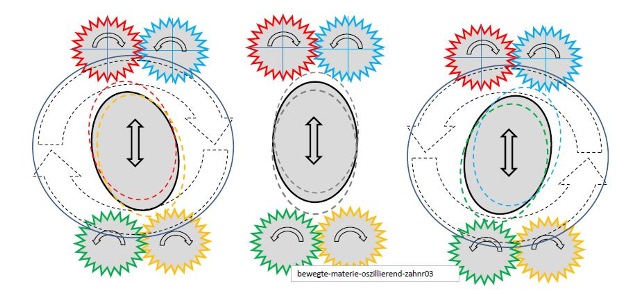 |
| Abb. 04-09: Zwei Zahnradpaare sind
auf einem gemeinsamen ringförmigen Träger befestigt,
der um eine ortsfeste Achse unterhalb des
elliptischen Körpers rotieren kann. Die Zahnradpaare sollen dauernd mit der durch Pfeile angedeuteten Drehrichtung rotieren. Der innere elliptische Körper wird periodisch nach oben und nach unten bewegt. Im mittleren Bild ist der Körper parallel zur Bewegungsrichtung und bei den beiden äußeren Bildern schrägt dazu ausgerichtet. Daher berührt er bei der Aufwärtsbewegung links das rote und rechts das blaue Zahnrad und bei der Abwärtsbewegung das gelbe bzw. das grüne. Im mittleren Bild berührt er beide. Während der Berührung wird durch die Rotation der Zahlräder auf den Träger ein Drehmoment ausgeübt, so daß er zusammen mit den Zahnradgruppen um seine Achse rotiert: links CW, rechts CCW und in der Mitte keine Rotation, weil die Zahnräder entgegengesetzt drehen. Die Berührung soll jeweils nur kurzzeitig sein, so daß nur eine sehr kleine Drehung des Trägers daraus erfolgt. Two pairs of gears are mounted on a common ring-shaped carrier which can rotate about a stationary axis below the elliptical body. The gear pairs are to rotate continuously with the direction of rotation indicated by arrows. The inner elliptical body is periodically moved up and down. In the middle picture, the body is aligned parallel to the direction of movement, and in the two outer pictures, it is aligned at an angle to it. Therefore, in the upward movement, it touches the red gear on the left and the blue gear on the right, and in the downward movement, it touches the yellow gear and the green gear, respectively. In the middle image, it touches both. During the contact, a torque is exerted on the carrier by the rotation of the number wheels, so that it rotates around its axis together with the gear groups: CW on the left, CCW on the right and no rotation in the middle, because the gears rotate in opposite directions. The contact should be only momentary in each case, so that only a very small rotation of the carrier results from it. (FB) |
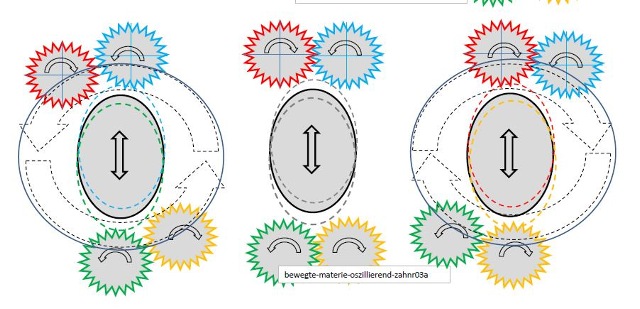 |
| Abb. 04-10: Verdrehung des Trägers
mit den Zahnrädern - jeweils etwa um einen halben
Zahnraddurchmesser, jeweils nach links bzw. nach
rechts. Die Wirkung ist dann umgekehrt zur der in der vorherigen Abbildung, wenn der elliptische Körper parallel zur Bewegung ausgerichtet ist. Damit ließe sich eine Schiefstellung des Körpers kompensieren. Rotation of the carrier with the gears - each by about half a gear diameter, respectively to the left and to the right. The effect is then the reverse of that in the previous figure, if the elliptical body is aligned parallel to the movement. This would compensate for a skewed position of the body. (FB) |
5. Rotierende Strömungen
5.1 Luftstrom und elektrisches Drehfeld
5. Rotating flows
5.1 Air flow and rotating electric field
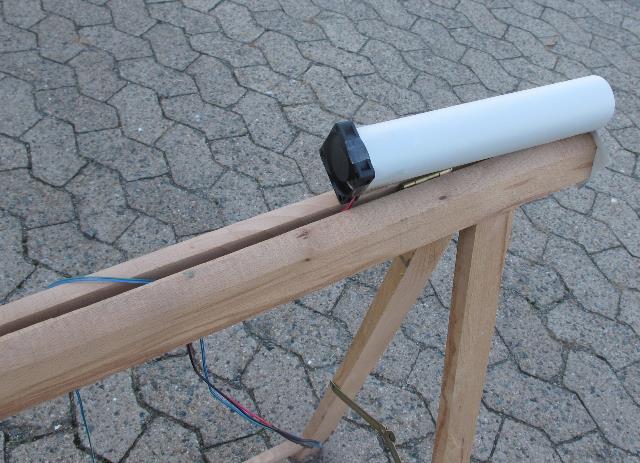 |
Abb. 05-01-01:aus eenergiesparlampe-gewendelt.htm#06-02-01 |
 |
Abb. 05-01-02:aus eenergiesparlampe-gewendelt.htm#06-02-01 |
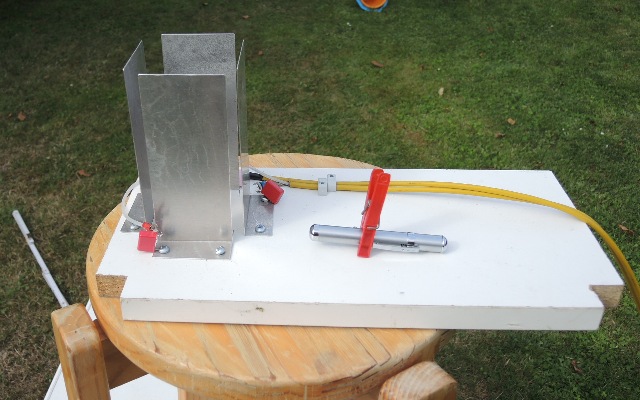 |
| Abb. 05-01-03: rotierendes
elektrisches Feld in einem Quadrupol-Kondensator rotating electric field in a quadrupole capacitor aus quadrupol-kondensator.htm |
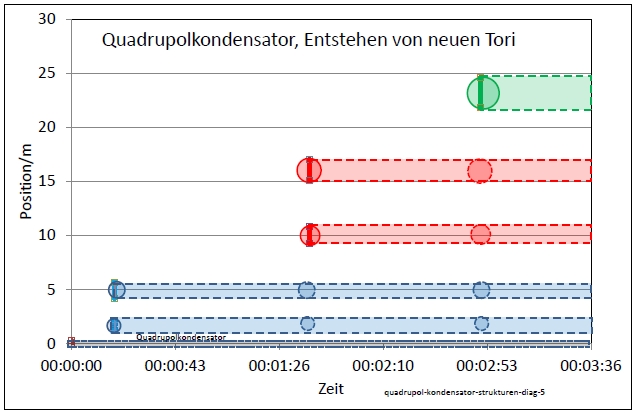 |
Abb. 05-01-04: mit der Zeit nimmt die
Anzahl der Toroide zuaus quadrupol-kondensator.htm |
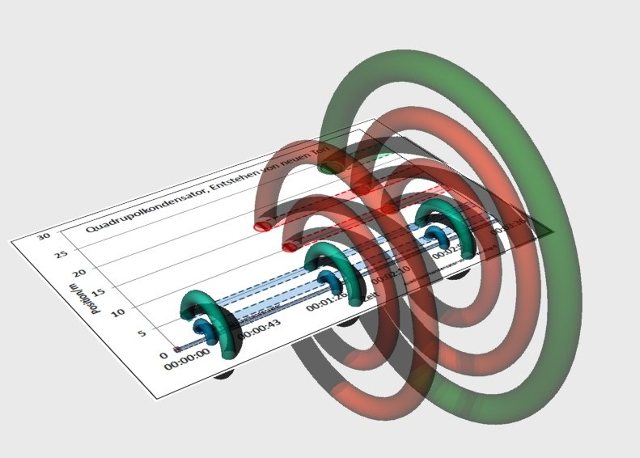 |
Abb. 05-01-05: mit der Zeit wächst
die Anzahl der Toroide an.aus quadrupol-kondensator.htm#kapitel-05-01 |
5.2 Ventilator Fan
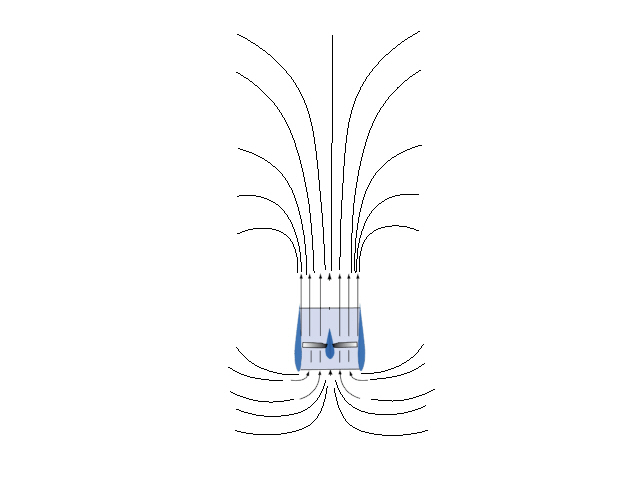 |
| Abb. 05-02-01: Strömung bei
einem kurzgeschlossenen Ventilator, angesaugt wird
unten, ausgeblasen nach oben. Der Strom nach
oben ist zunächst parallel, bevor er sich zur Seite
zerteilt. Unten wird hauptsächlich von der Seite
eingeströmt. Farbbild aus https://de.wikipedia.org/wiki/Ventilator#/media/Datei:Ducted_fan_principle.png, Linien ergänzt Flow in a short-circuited fan, sucked in at the bottom, blown out at the top. The flow upwards is initially parallel before it splits to the side. The flow at the bottom is mainly from the side. Color image from https://de.wikipedia.org/wiki/Ventilator#/media/Datei:Ducted_fan_principle.png, lines added (FB) |
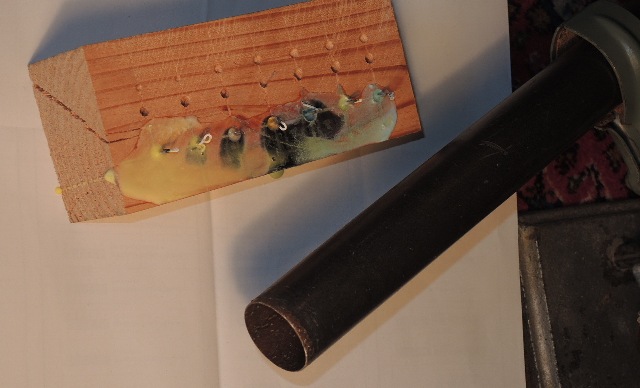 |
| Abb. 05-02-02: Staubsaugerrohr und
Holzbrett mit Geburtstagskerzen (nach dem
Experiment) Vacuum cleaner tube and wooden board with birthday candles (after the experiment). FB |
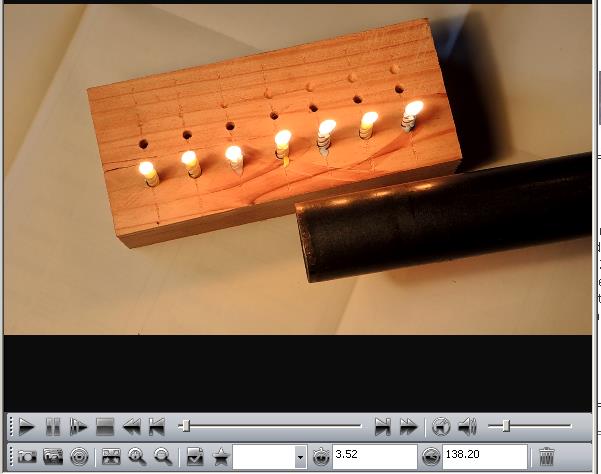 |
| Abb. 05-02-03: Beginn, Video: 3,52 s Die Kerzen brennen seit etwa einer Minute, der Staubsauger ist noch nicht eingeschaltet Nummer der Kerze von links nach rechts: 1 2 3 4 5 6 7 The candles have been burning for about one minute, the vacuum cleaner is not yet switched on Number of the candle from left to right: 1 2 3 4 5 6 7 (FB) |
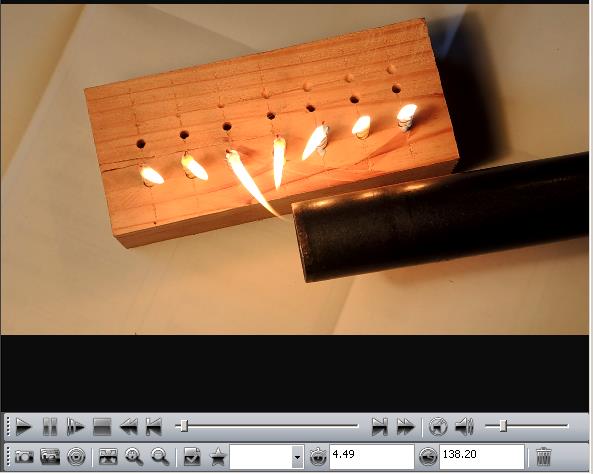 |
| Abb. 05-02-04: Video 4.49 s Der Staubsauger ist gerade eingeschaltet. Seine Drehzahl steigt langsam an, bei der Kerze 3 ist die größte Geschwindigkeit, danach kommt 4 und 5 The vacuum cleaner is just switched on. Its speed increases slowly, at the candle 3 is the highest speed, then comes 4 and 5 (FB) |
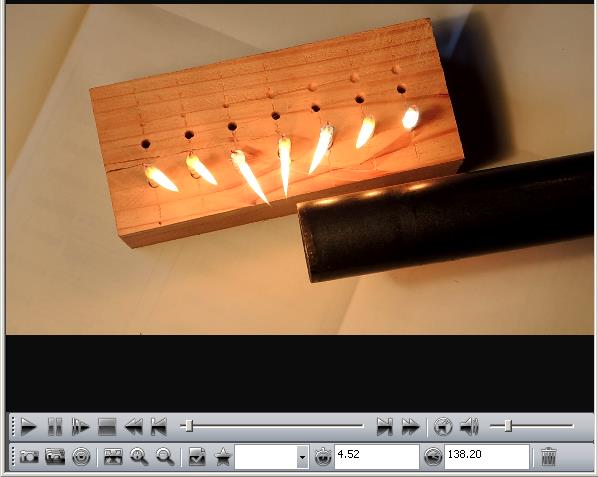 |
| Abb. 05-02-05: Video 4.52 s Bei 3, 4 und 5 ist der größte Sog At 3, 4 and 5 is the greatest suction(FB) |
 |
| Abb. 05-02-06: Video 4.61 s Die Drehzahl und der Sog sind weiter angestiegen. Nun haben auch 1,2 und 6,7 lange Flammen. Die von 3,4,5 sind schlanker geworden, der Sog dort ist sehr stark. The speed and suction have increased further. Now 1,2 and 6,7 also have long flames. Those of 3,4,5 have become slimmer, the suction there is very strong. (FB) |
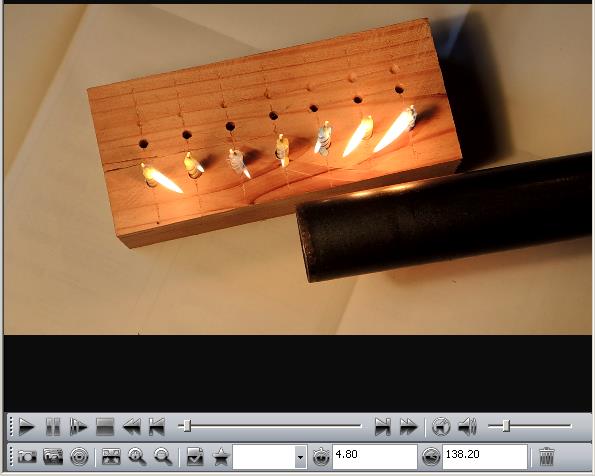 |
| Abb. 05-02-07: Video 4.80 s Bei noch stärkerem Sog brennen 2 bis 5 nur noch sehr schwach. With even stronger suction, 2 to 5 burn only very weakly. (FB) |
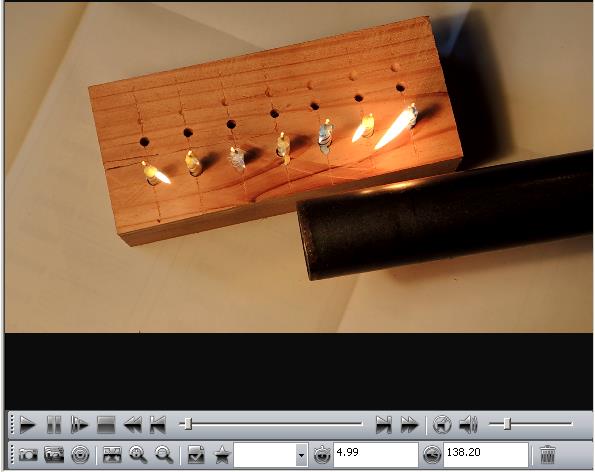 |
| Abb. 05-02-08:Video 4.99 s 2 bis 5 sind fast erloschen 2 to 5 are almost extinct (FB) |
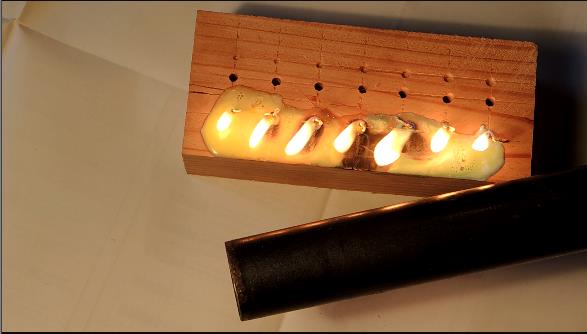 |
| Abb. 05-02-09: Das Holzbrett ist
weiter nach rechts verschoben. Auch dort gibt es
eine Strömung in Richtung zur Ansaugöffnung hin. The wooden board is shifted further to the right. There is also a flow there in the direction of the suction opening (FB) |
Literatur: b-literatur.htm
 |
www.biosensor-physik.de | (c)
04.03.2020 - 17.02.2025 F.Balck |
© BioSensor-Physik 2025 · Impressum
